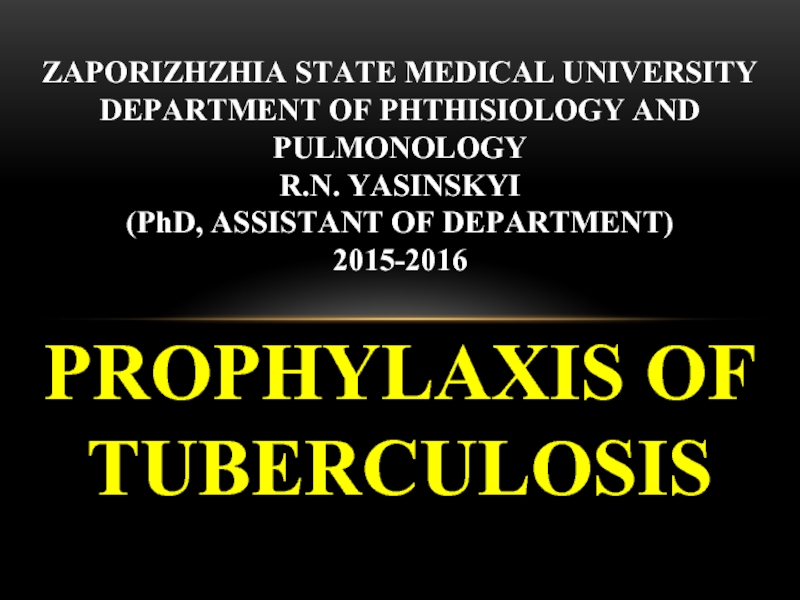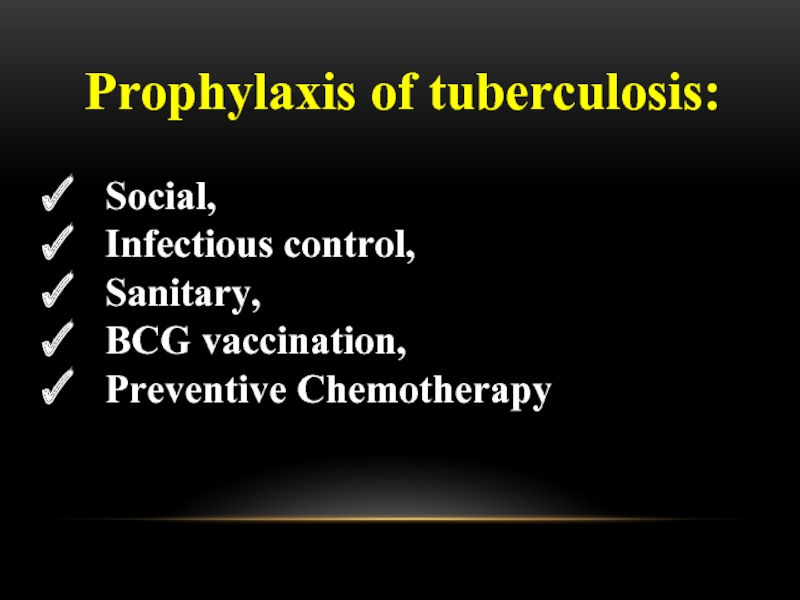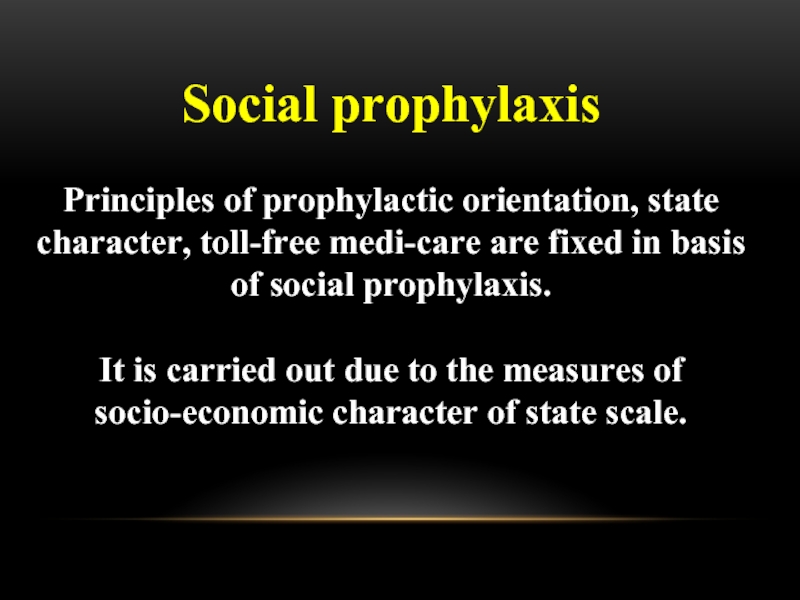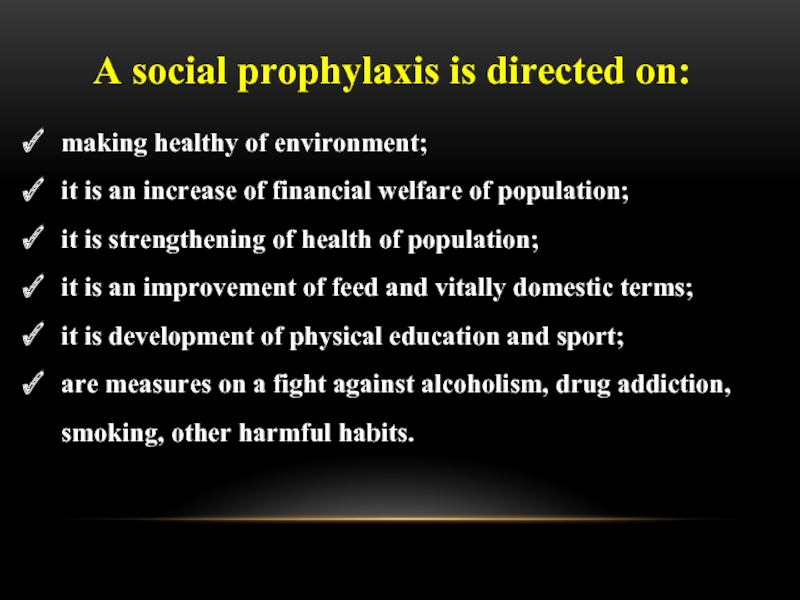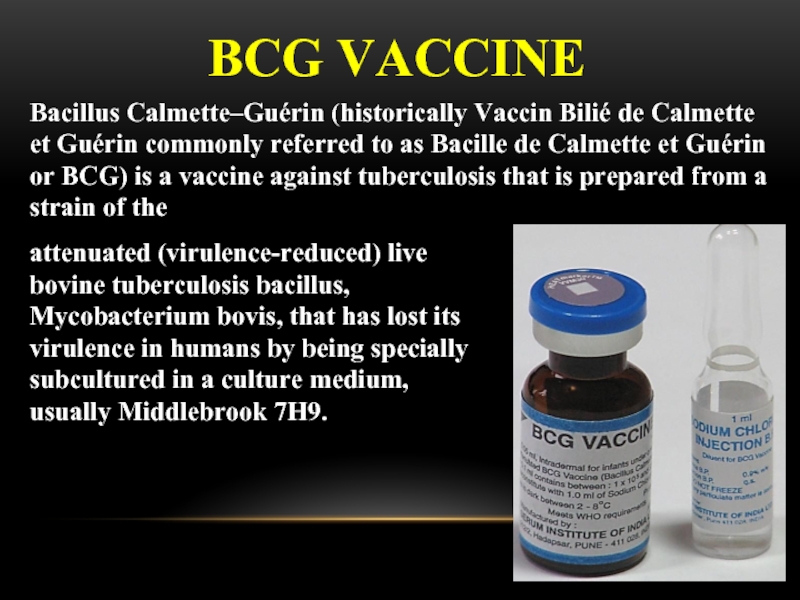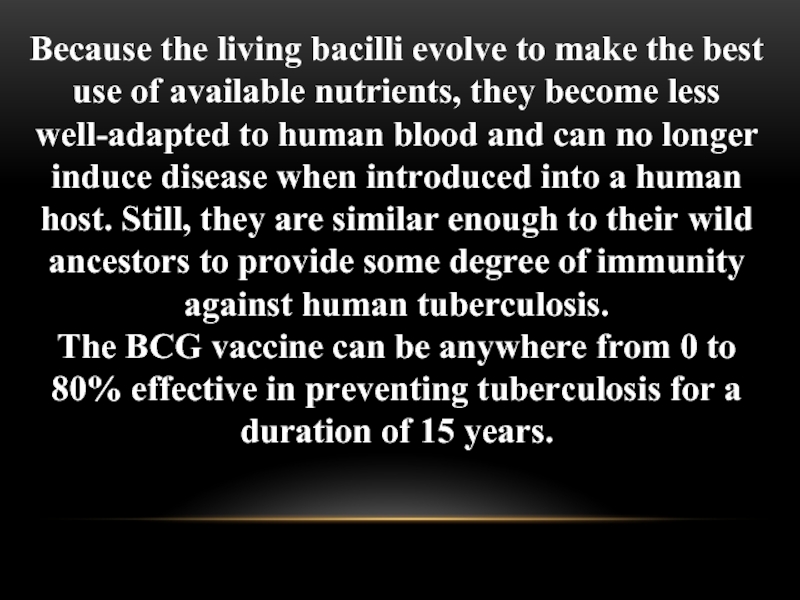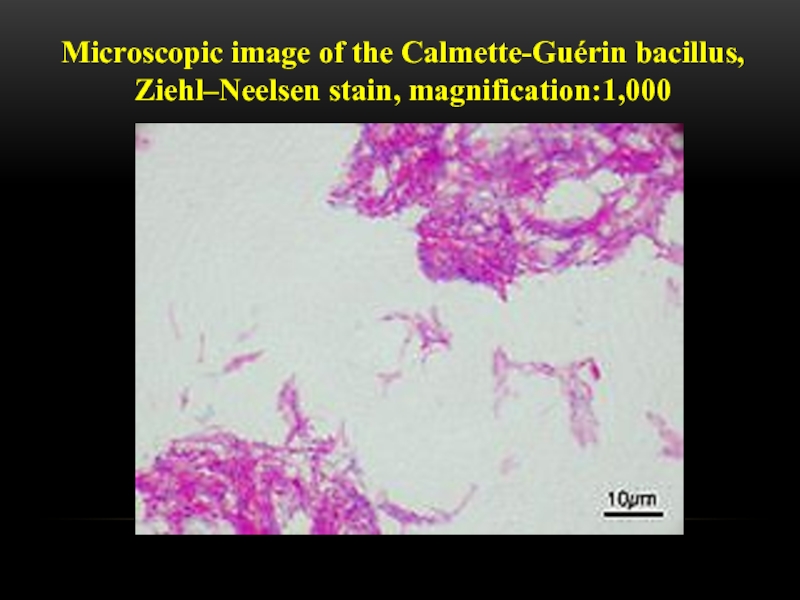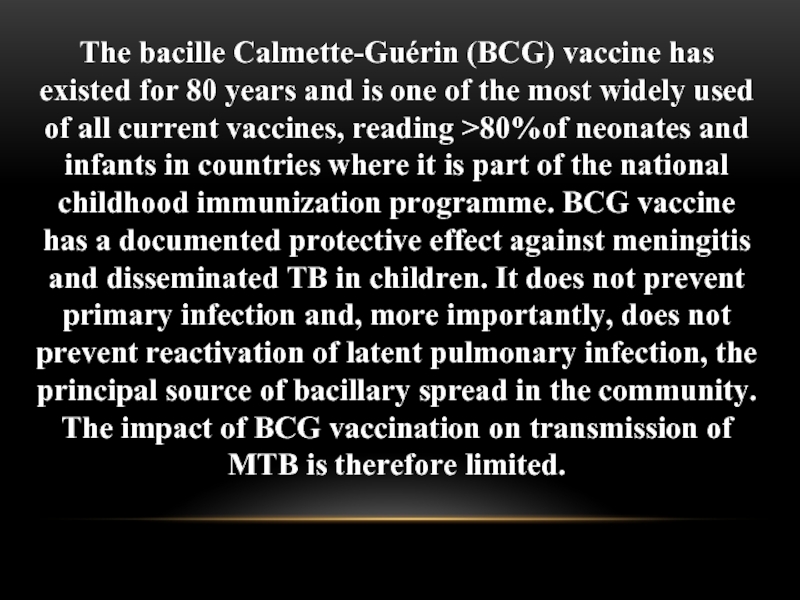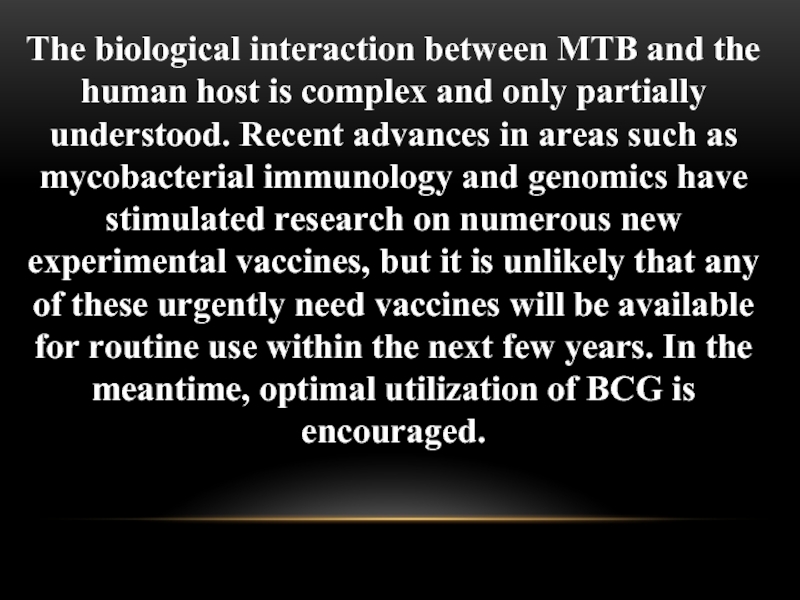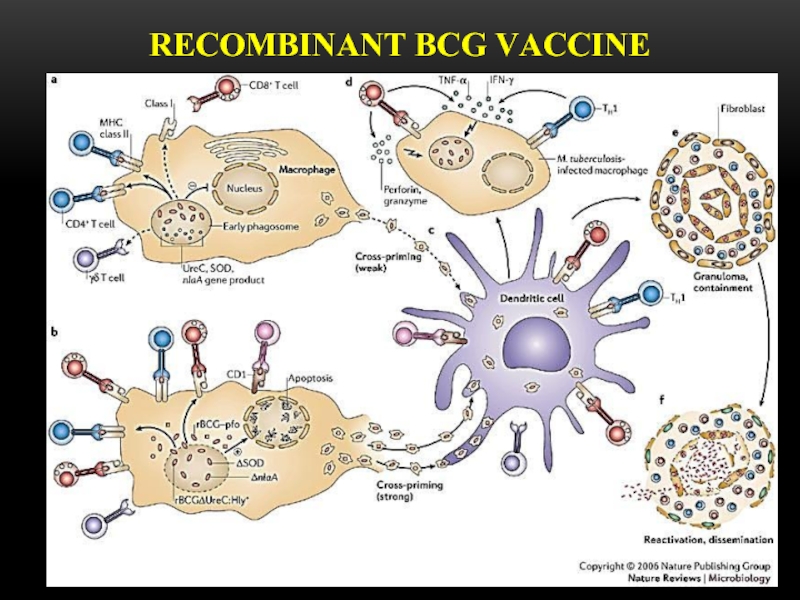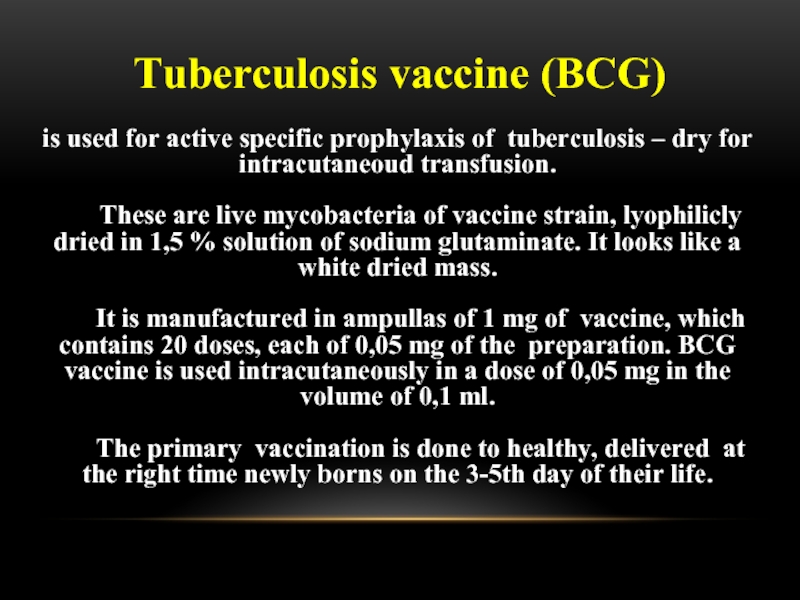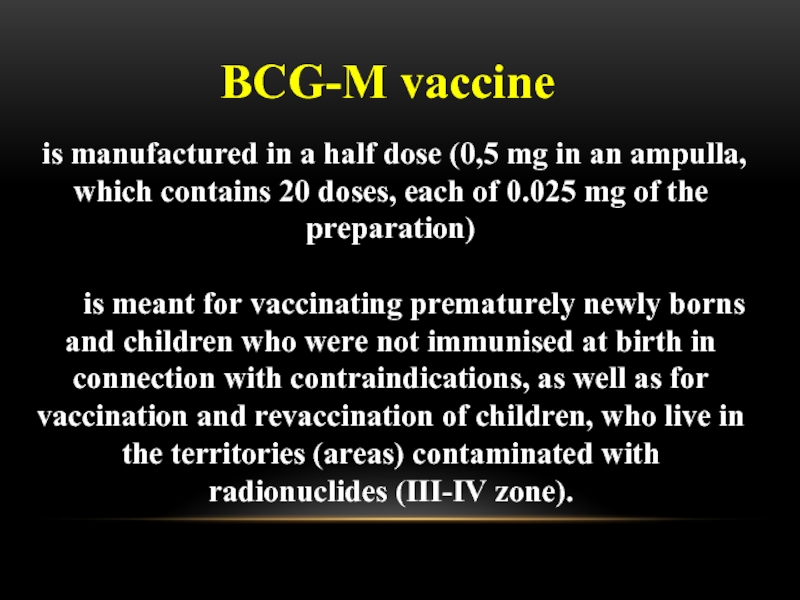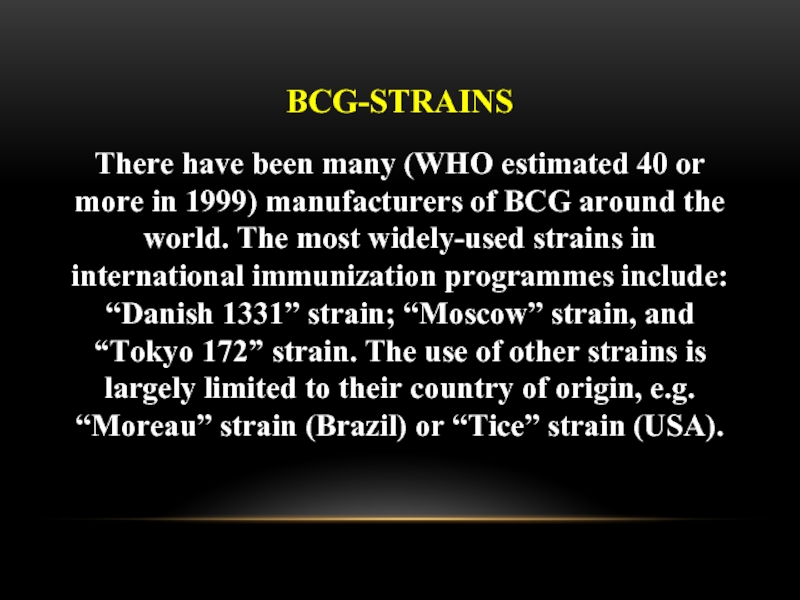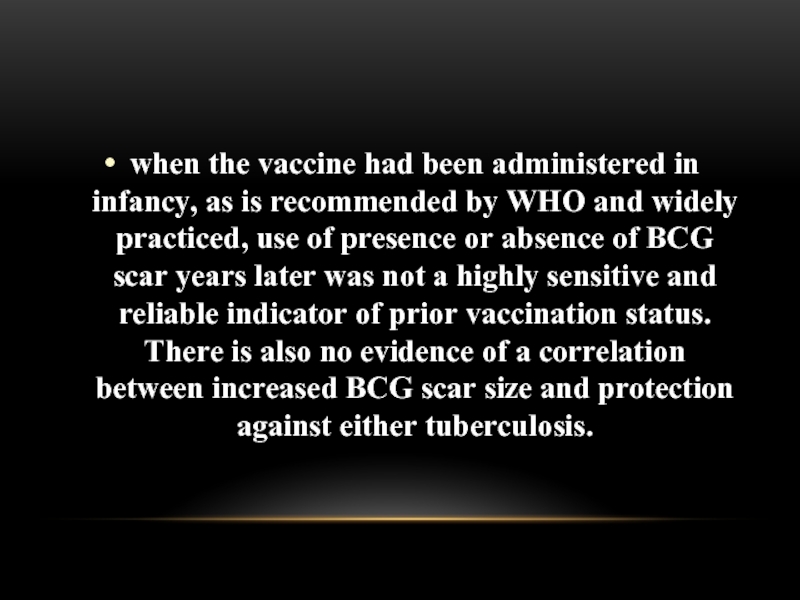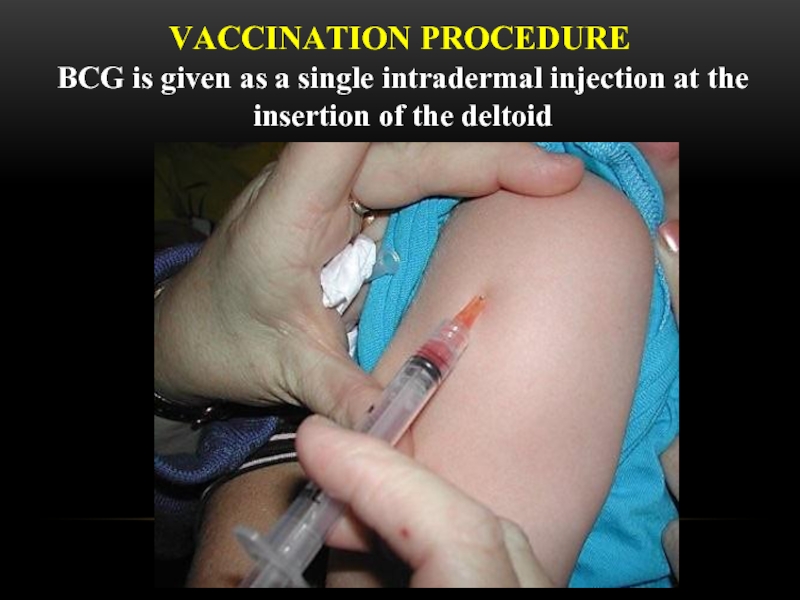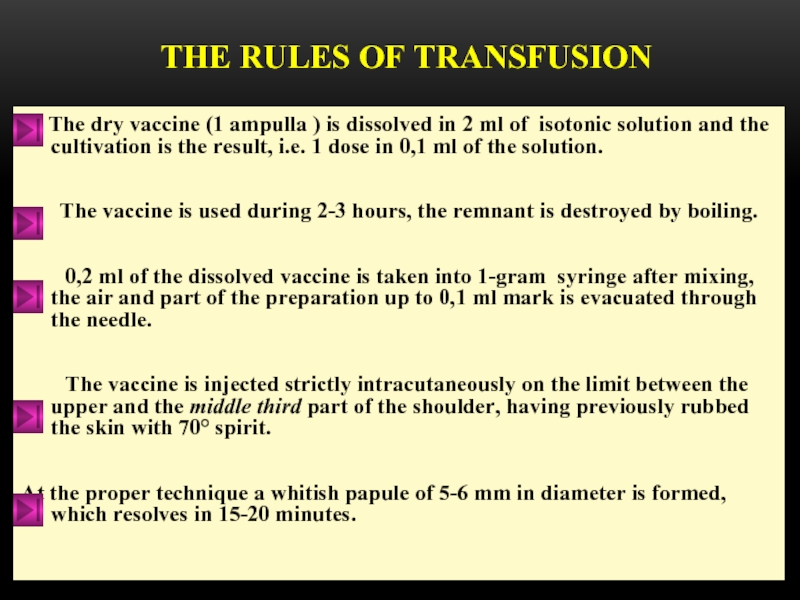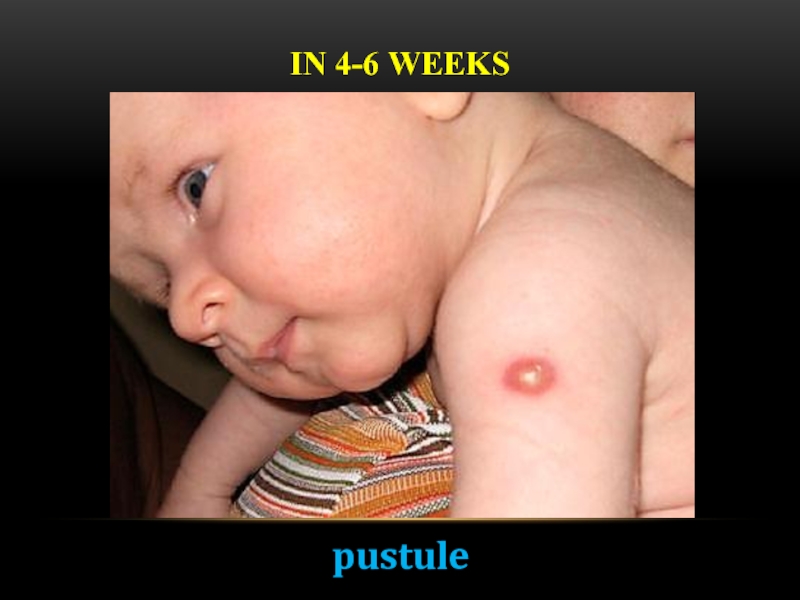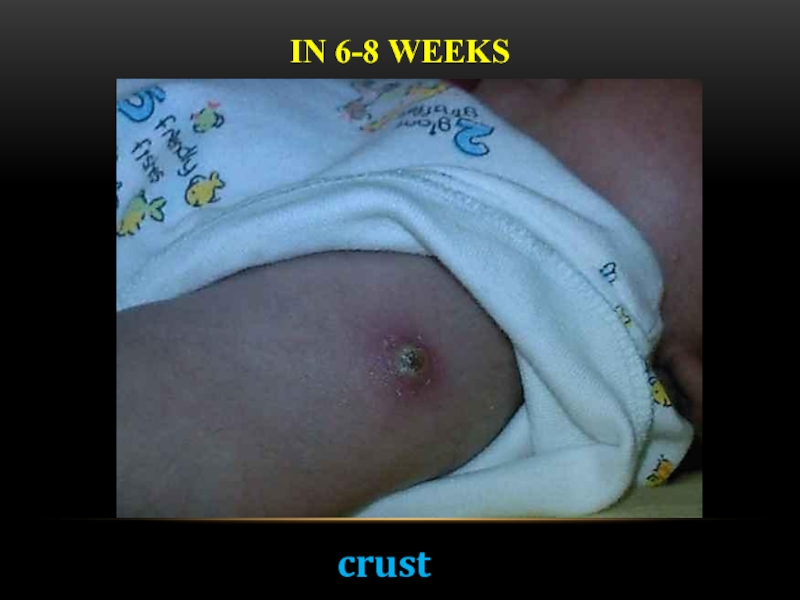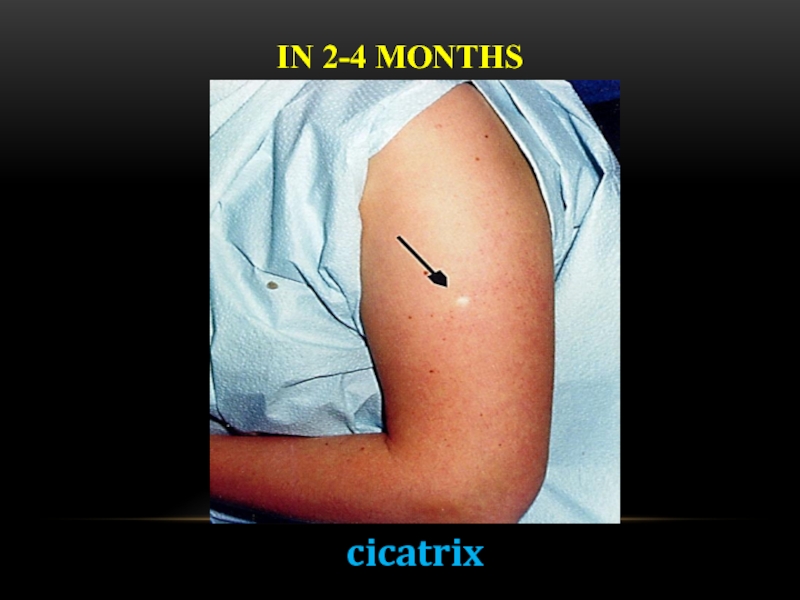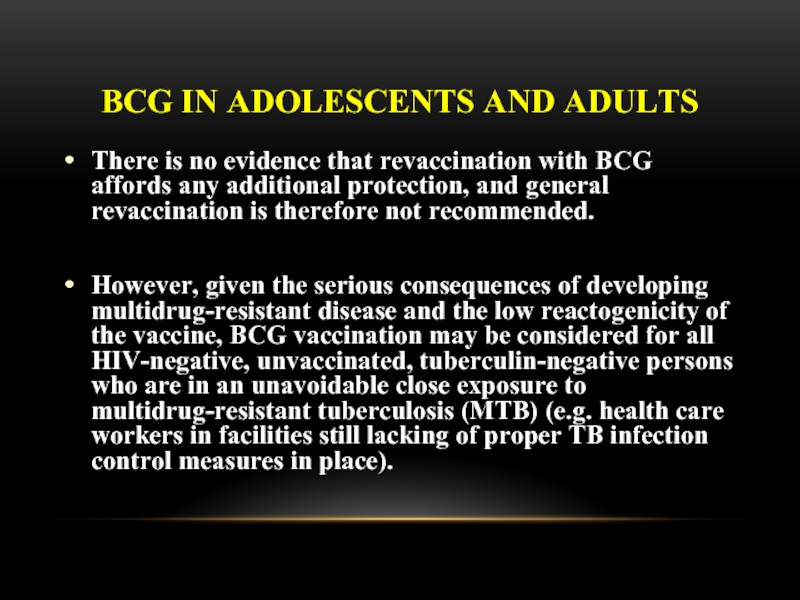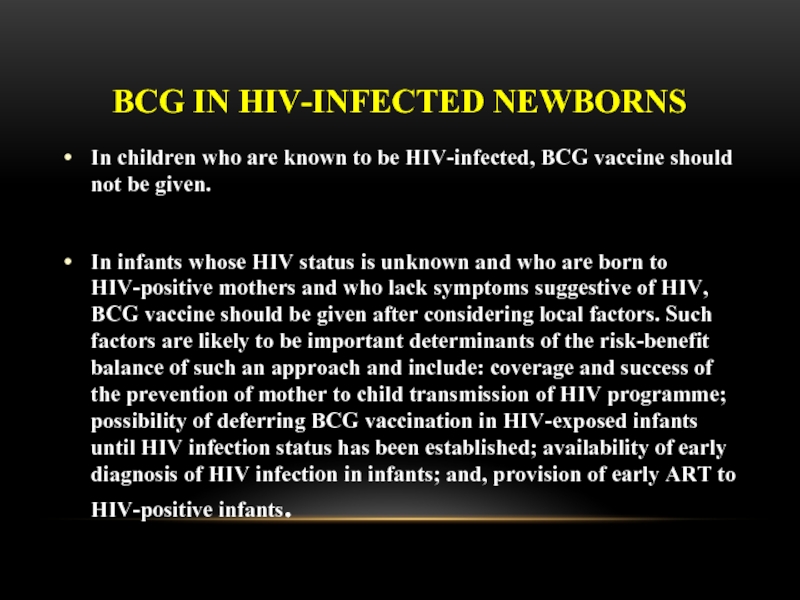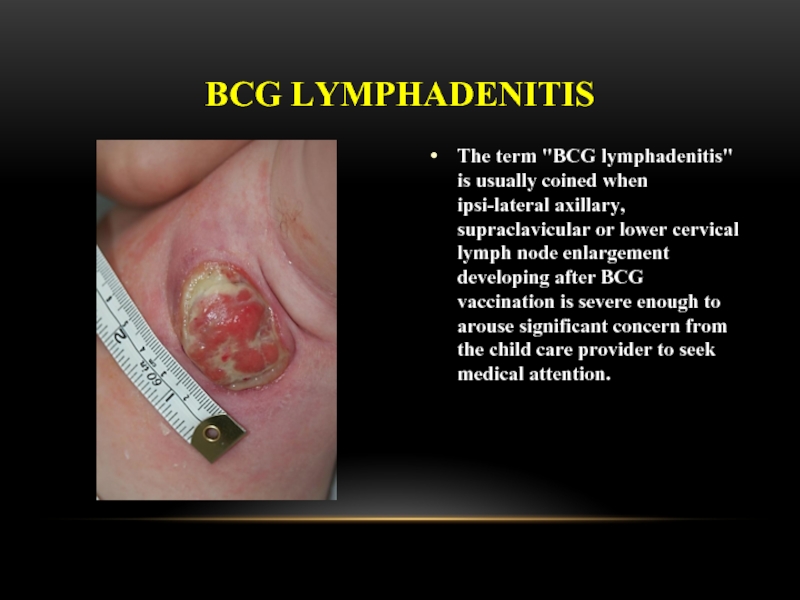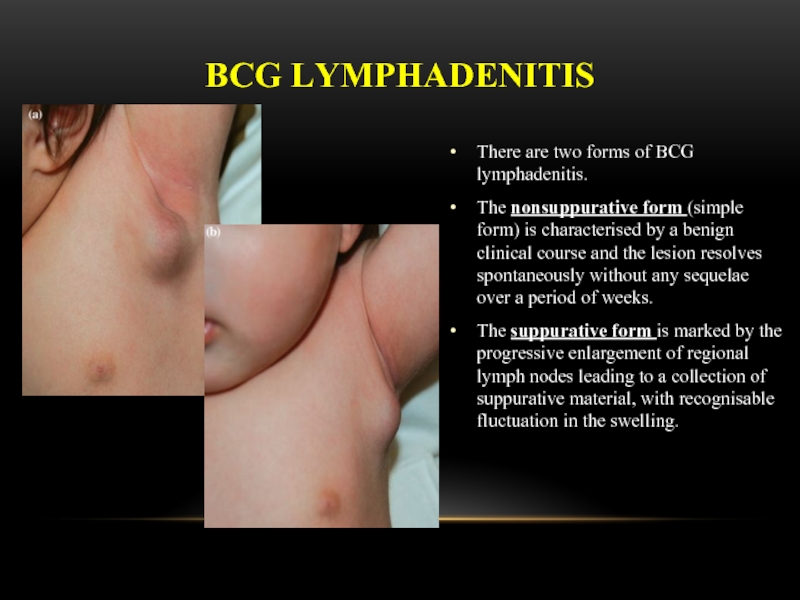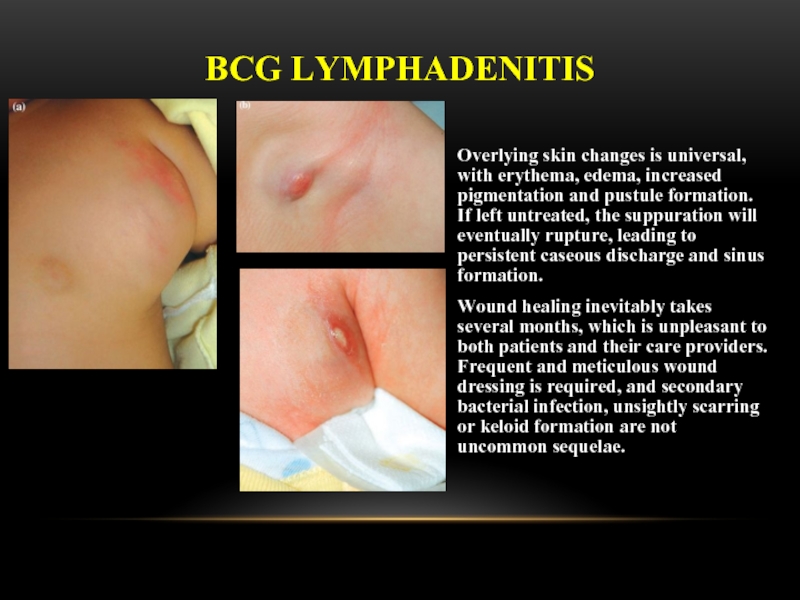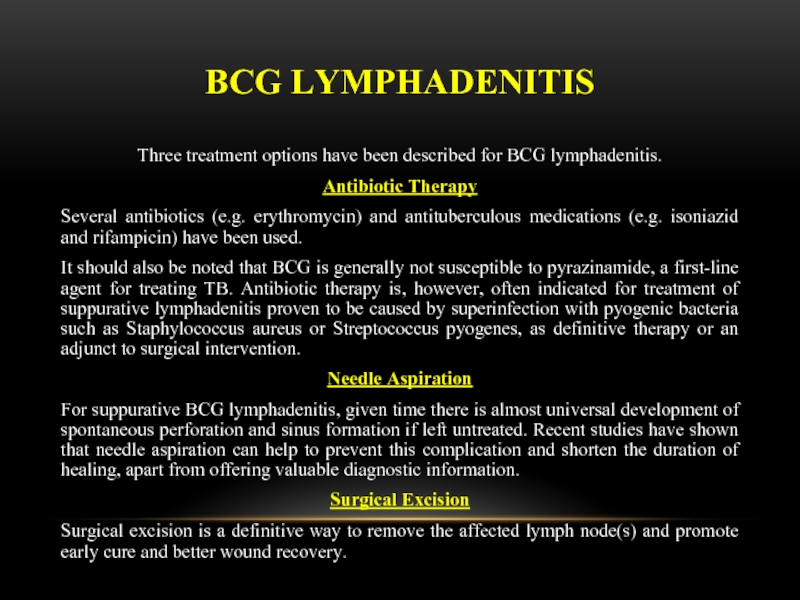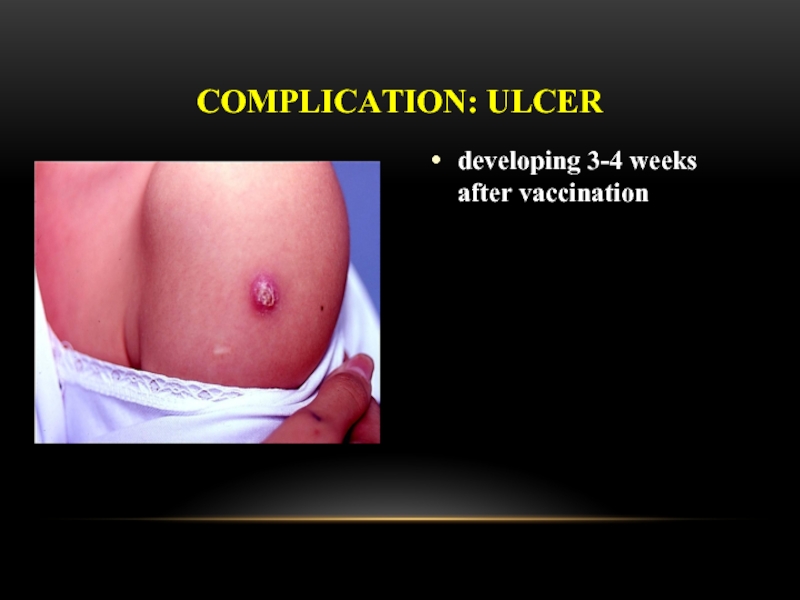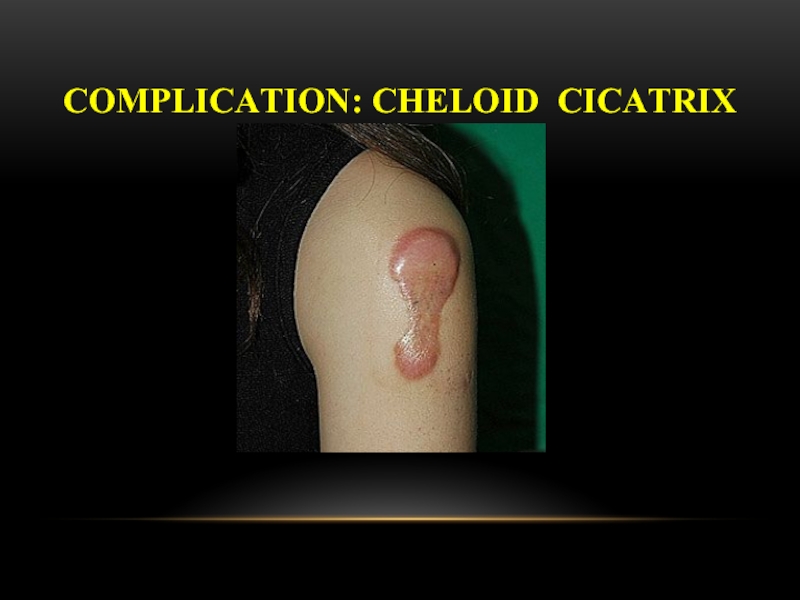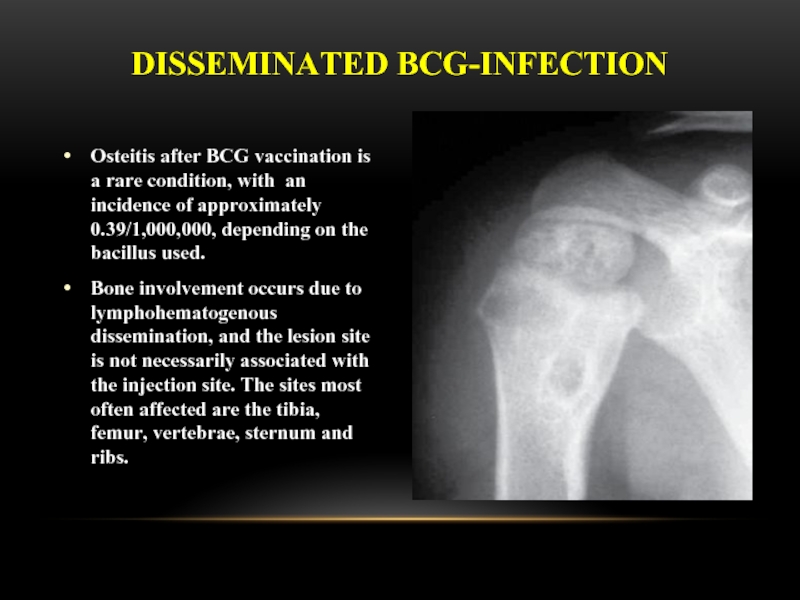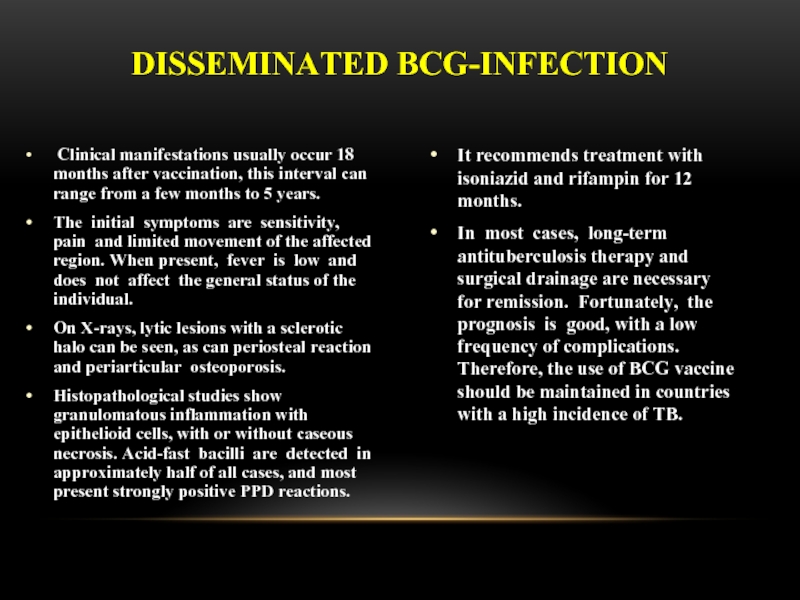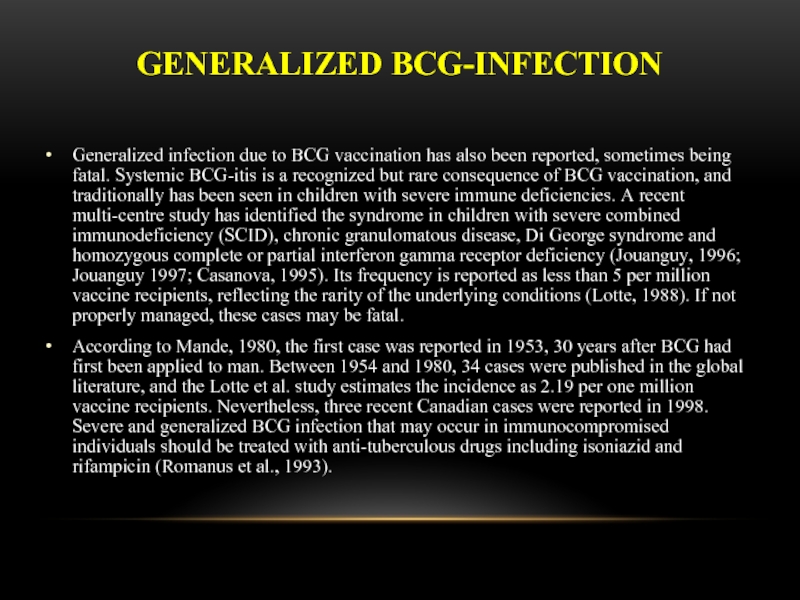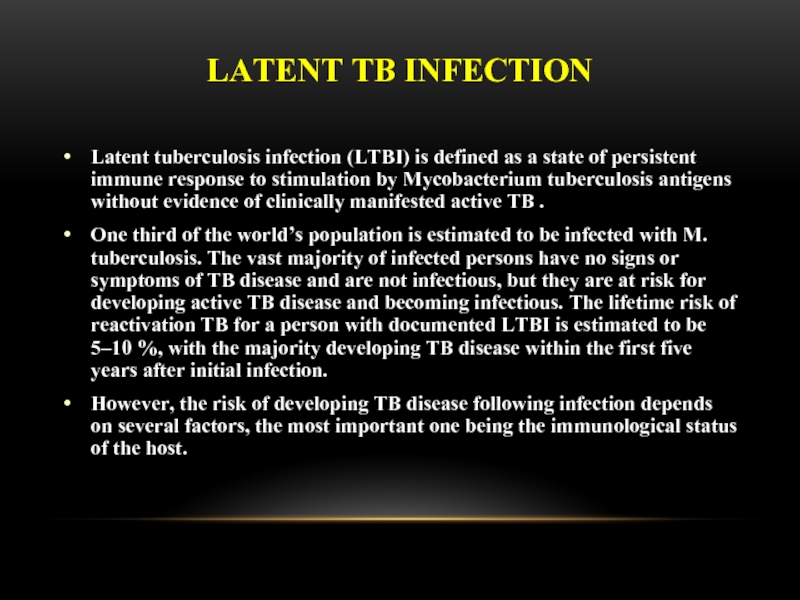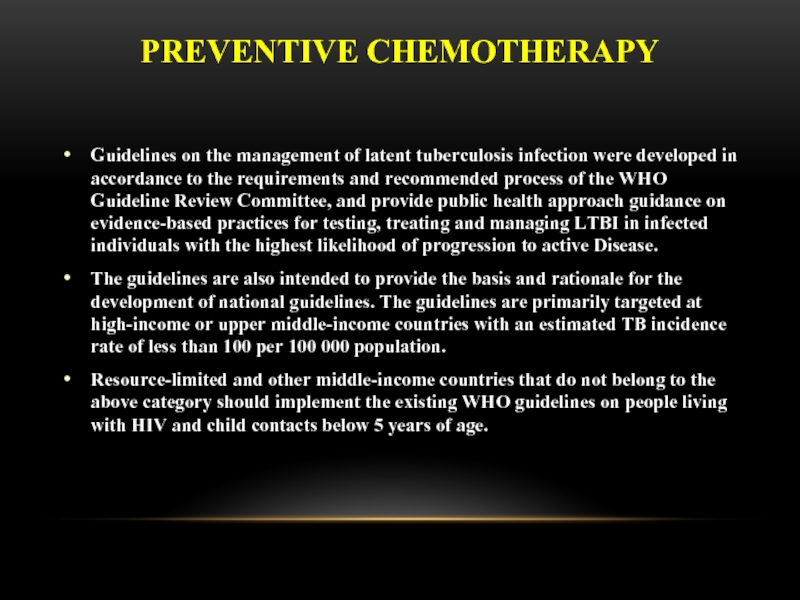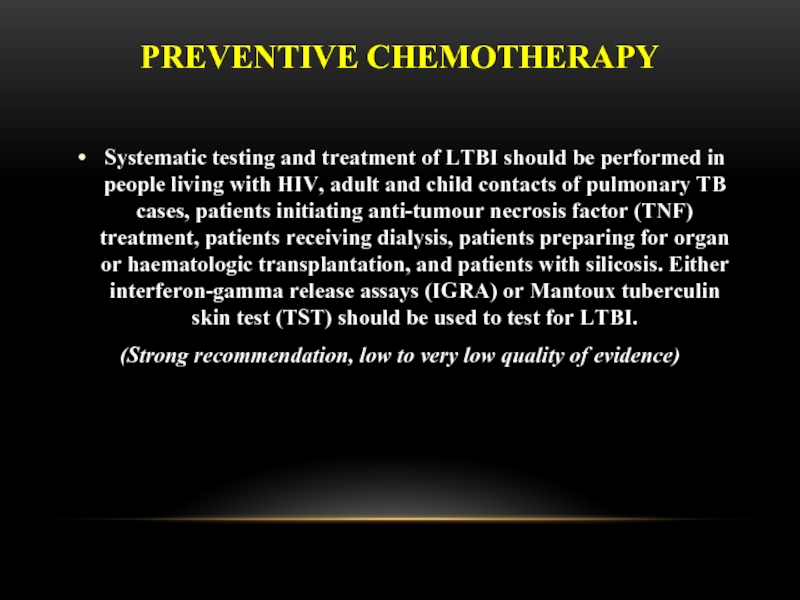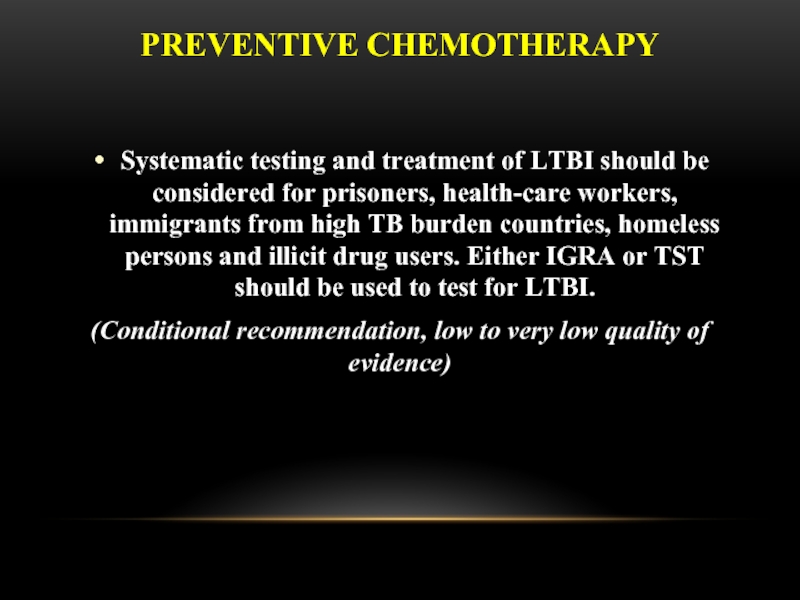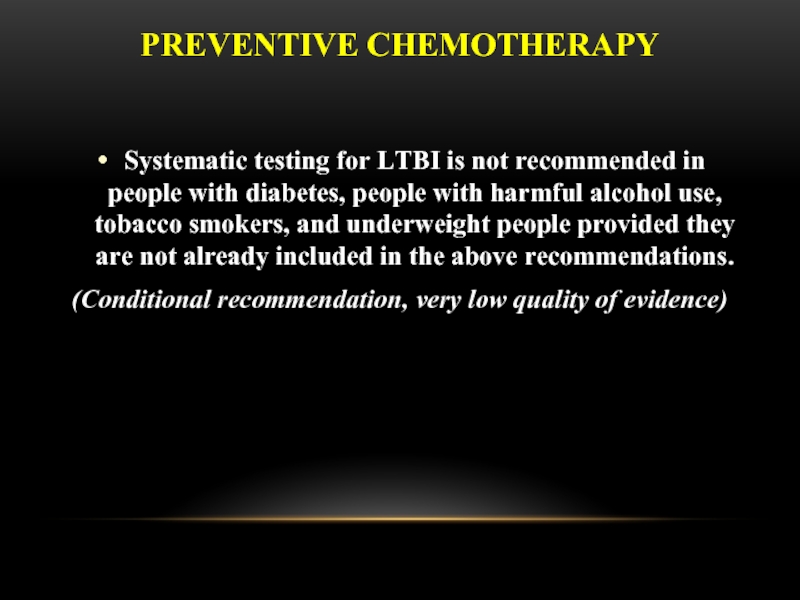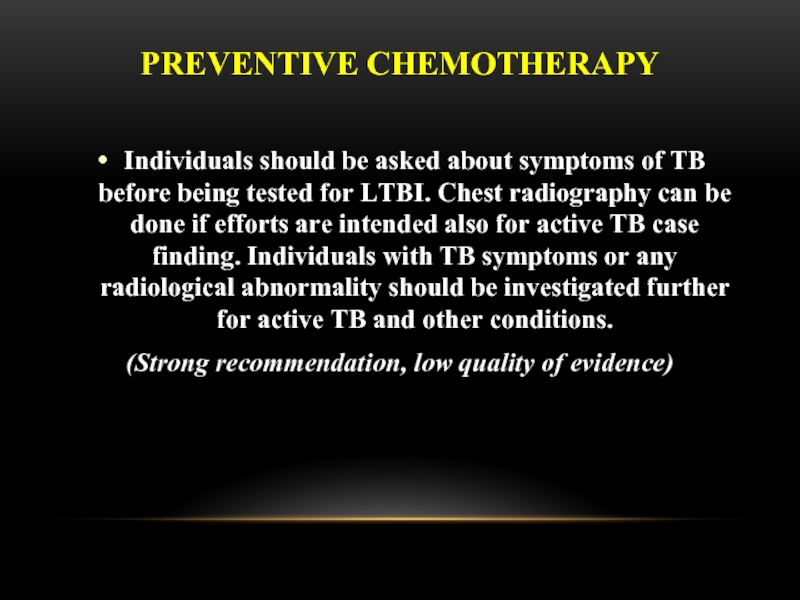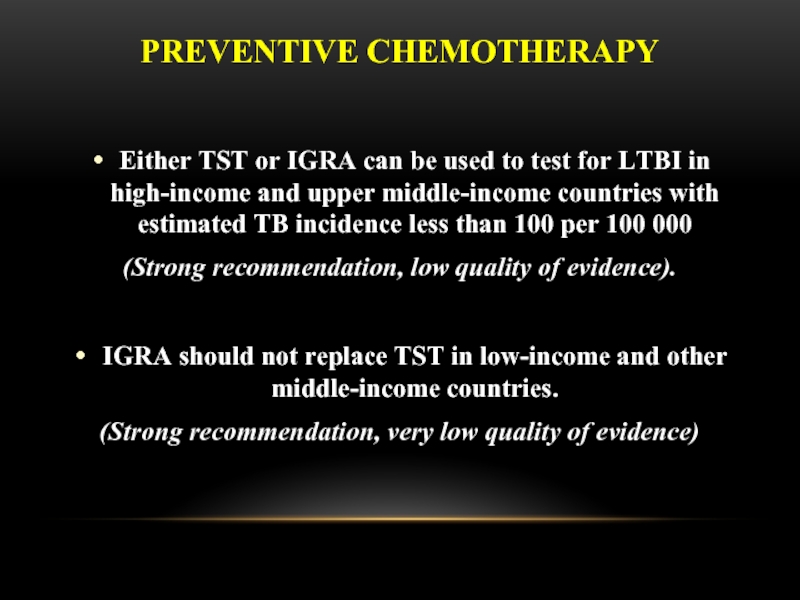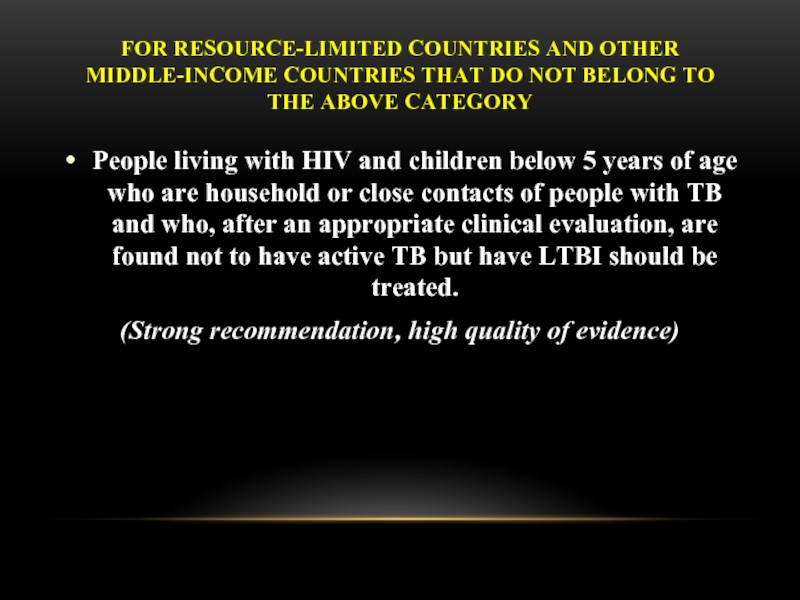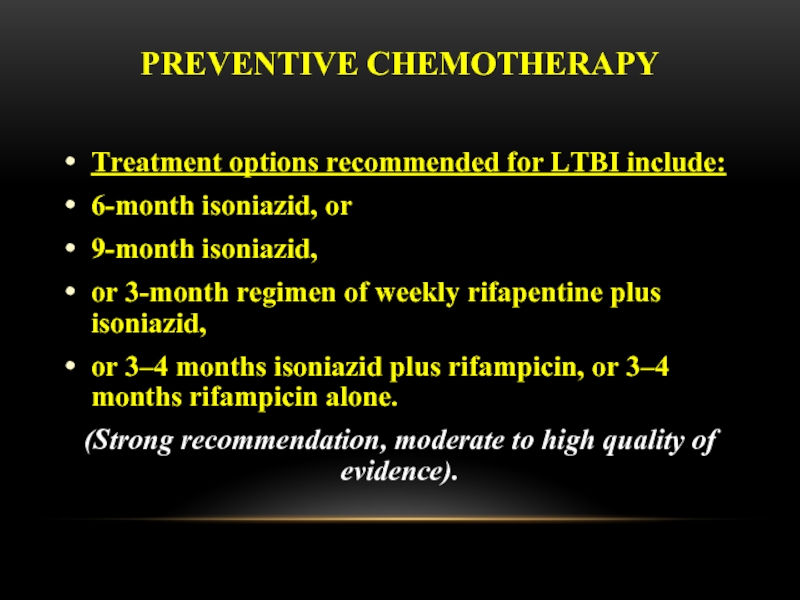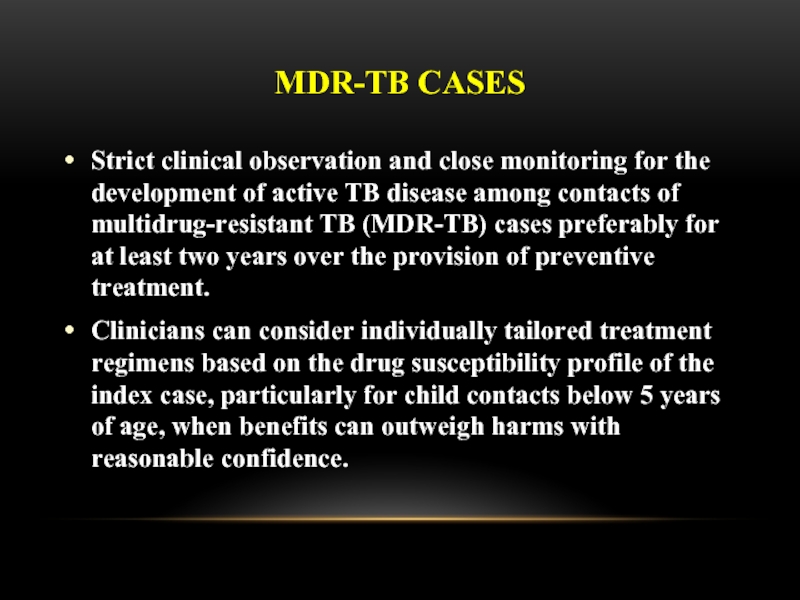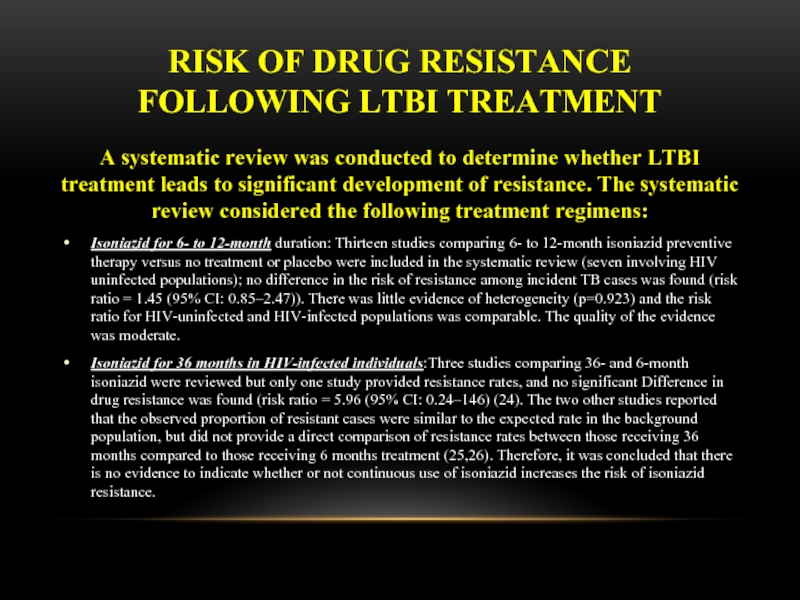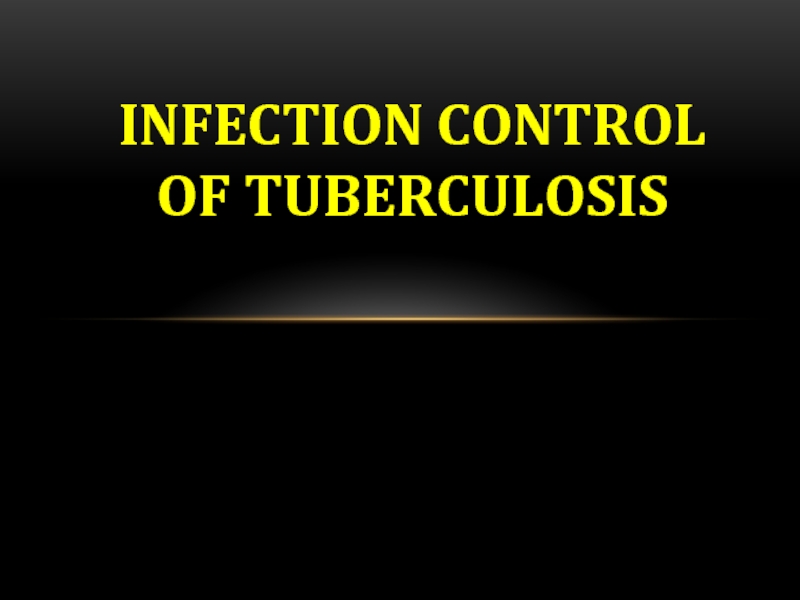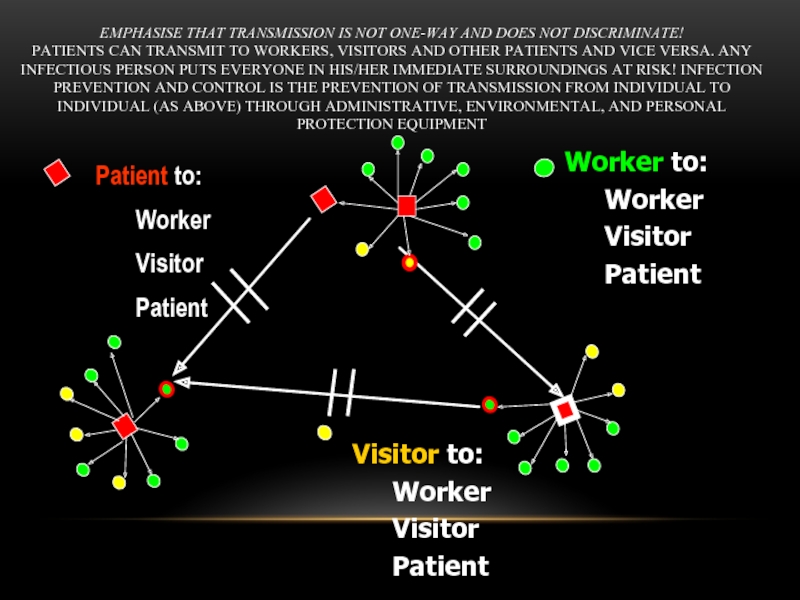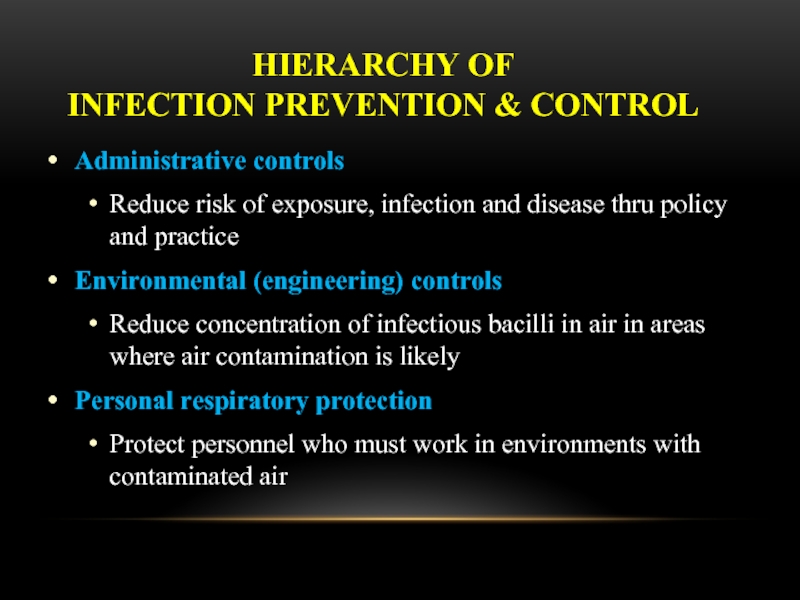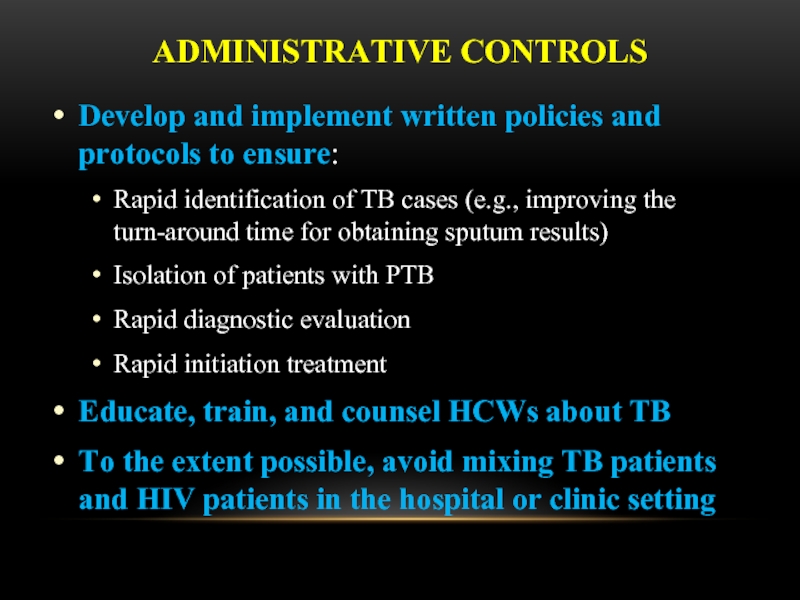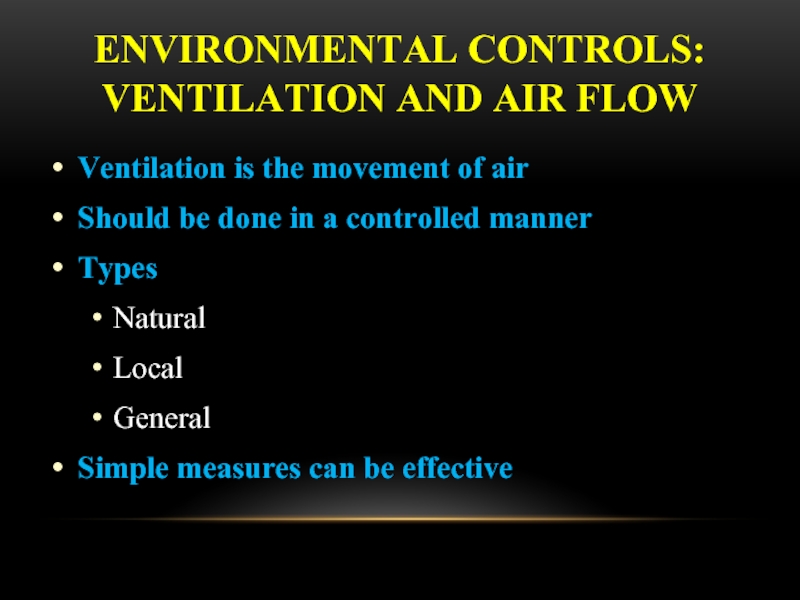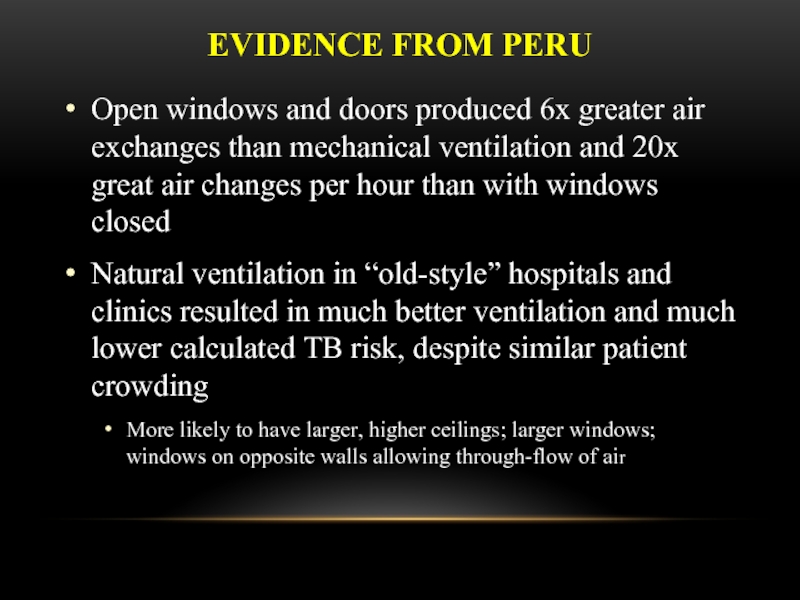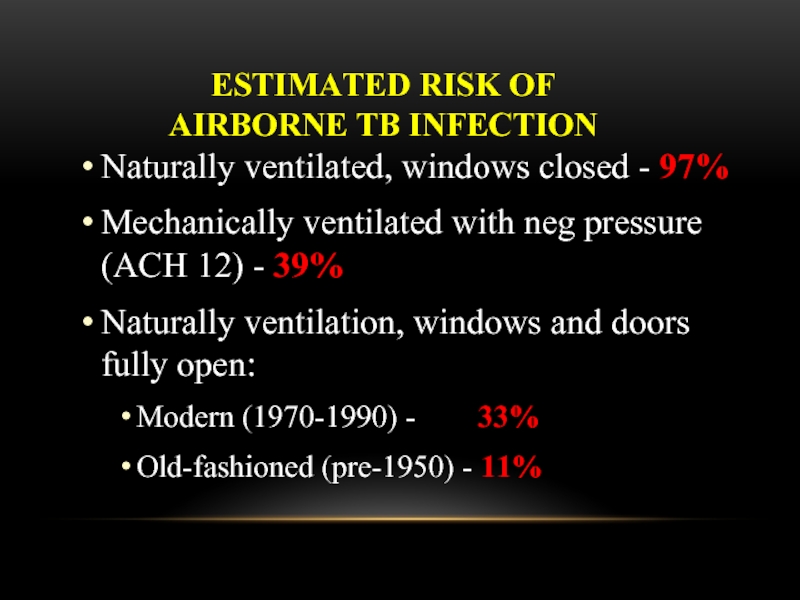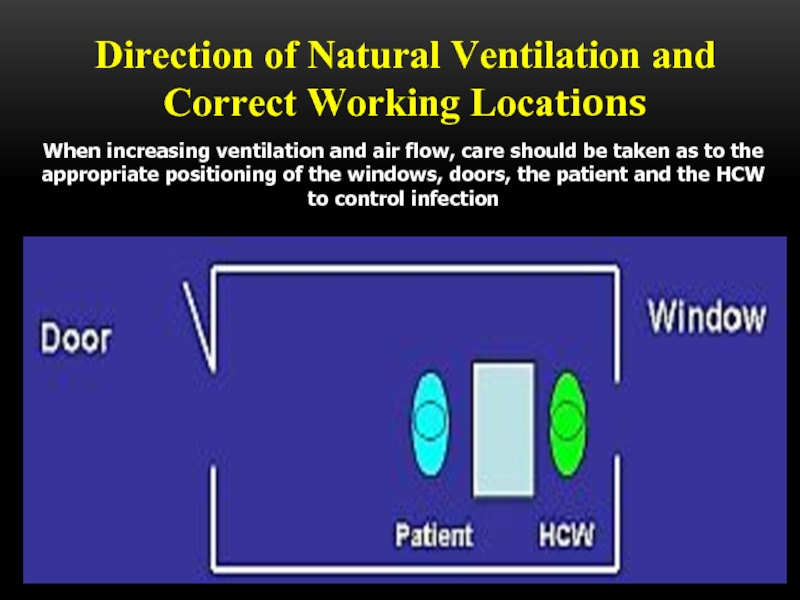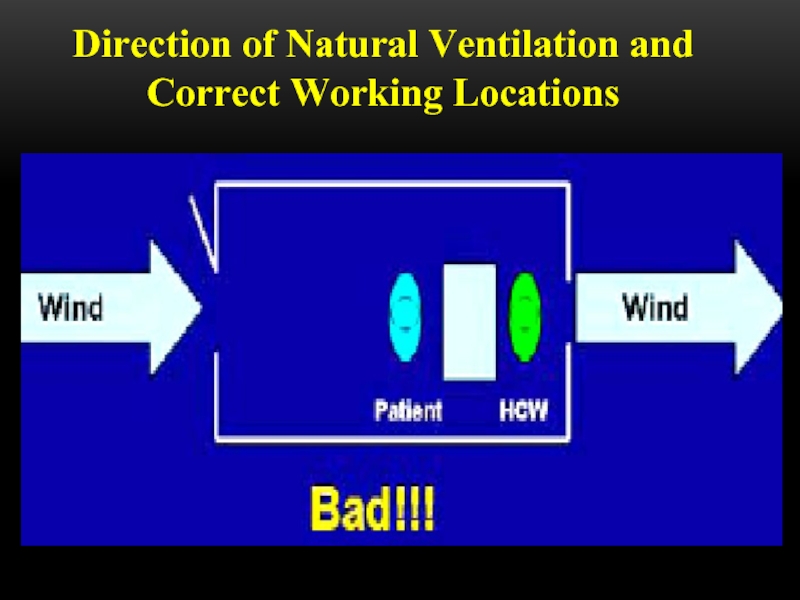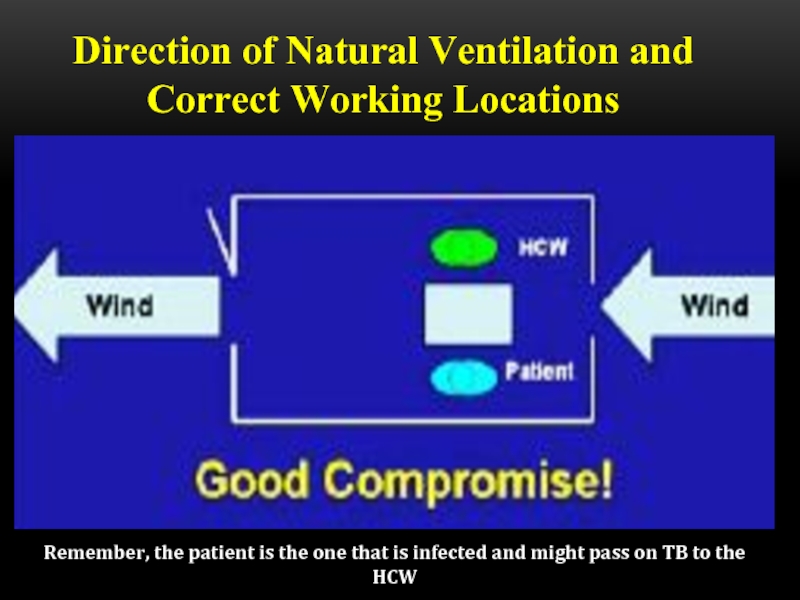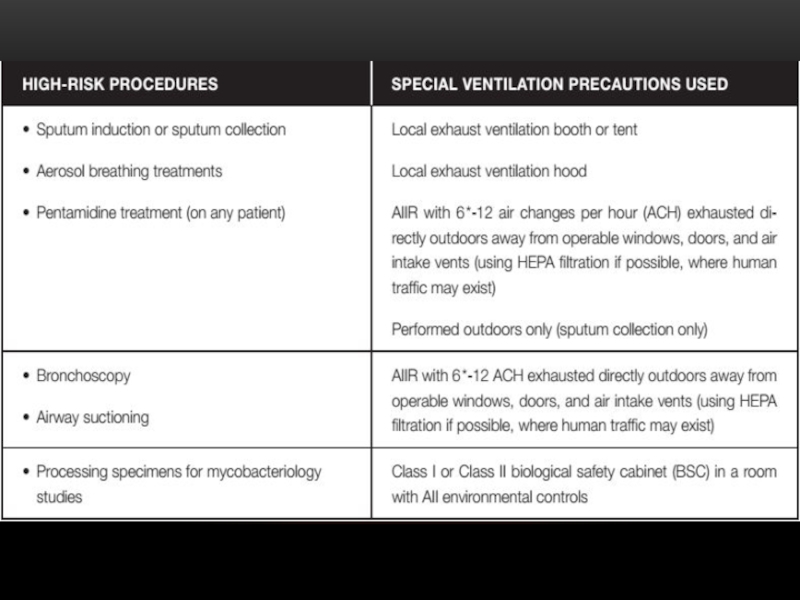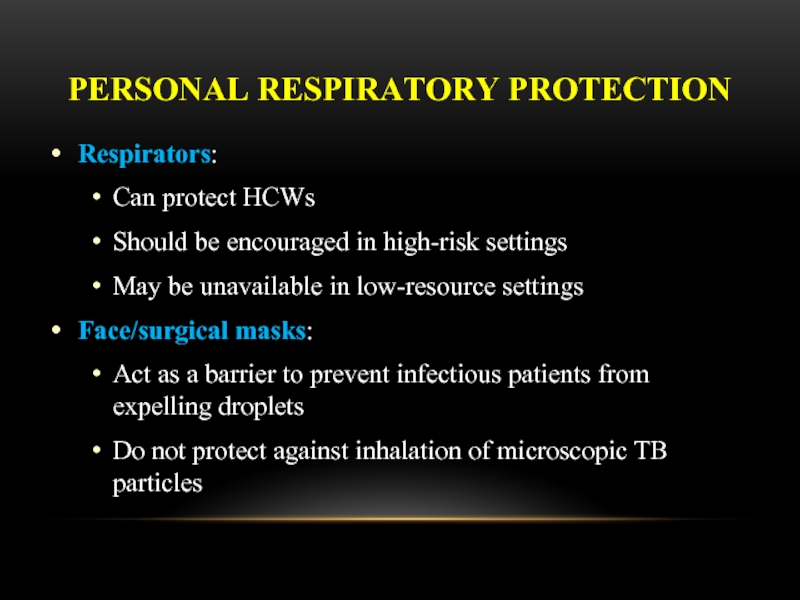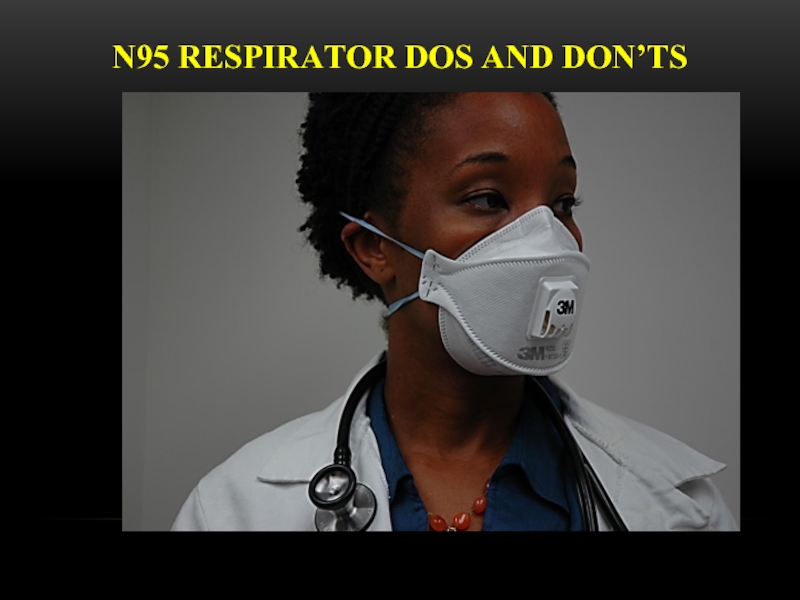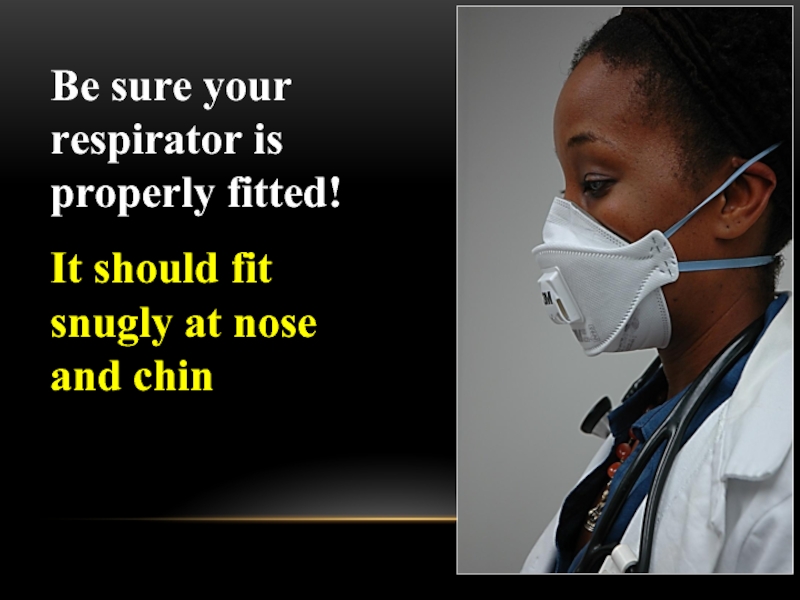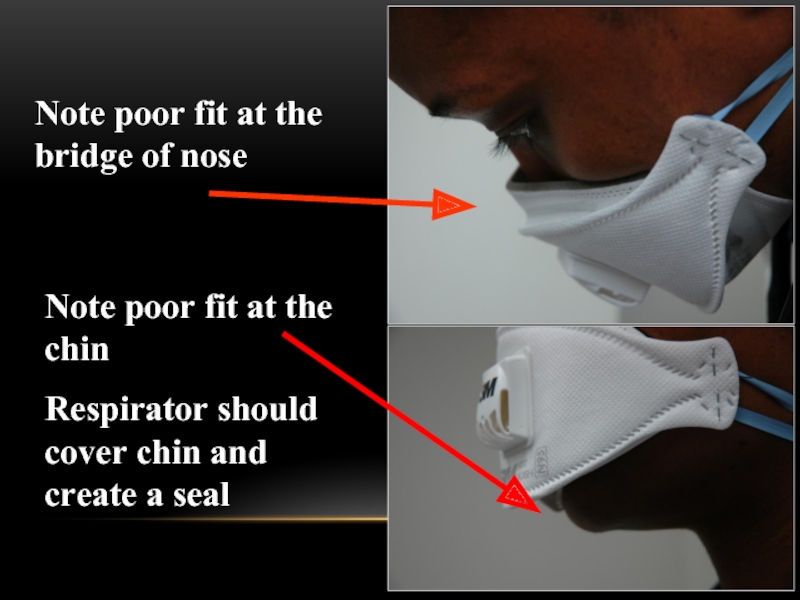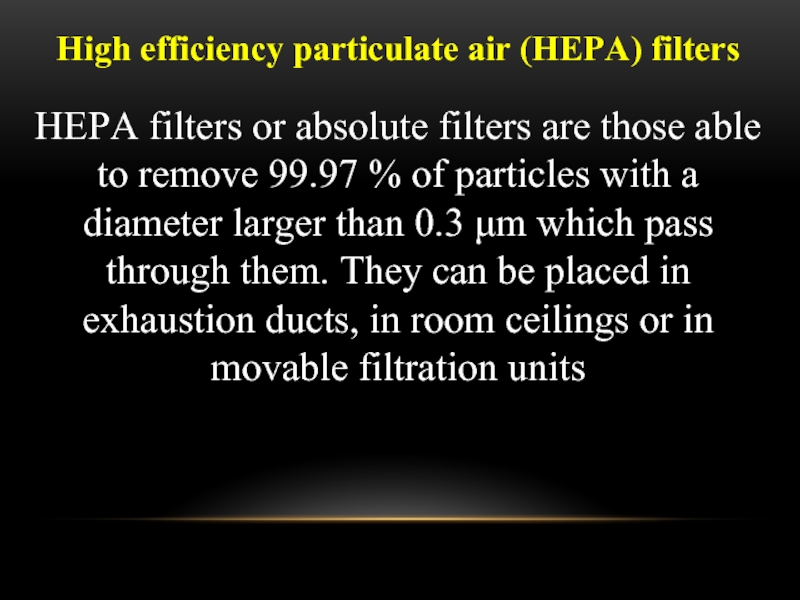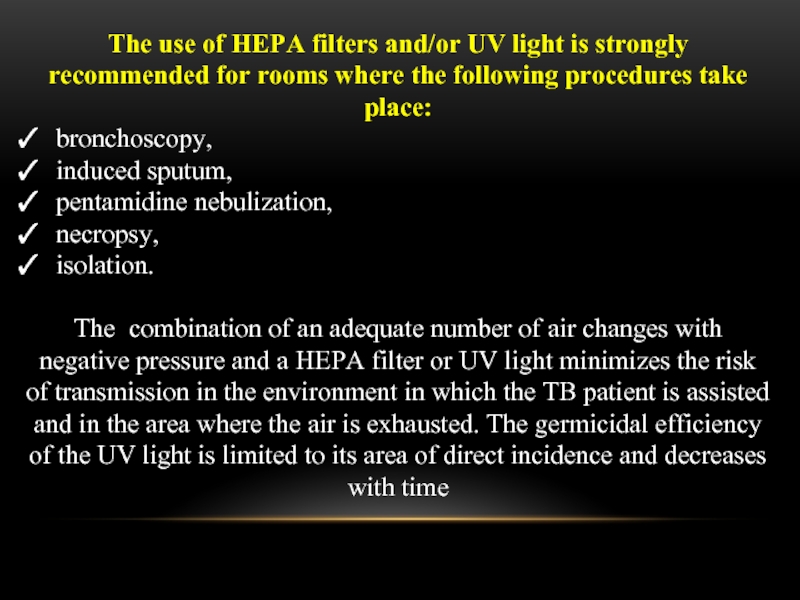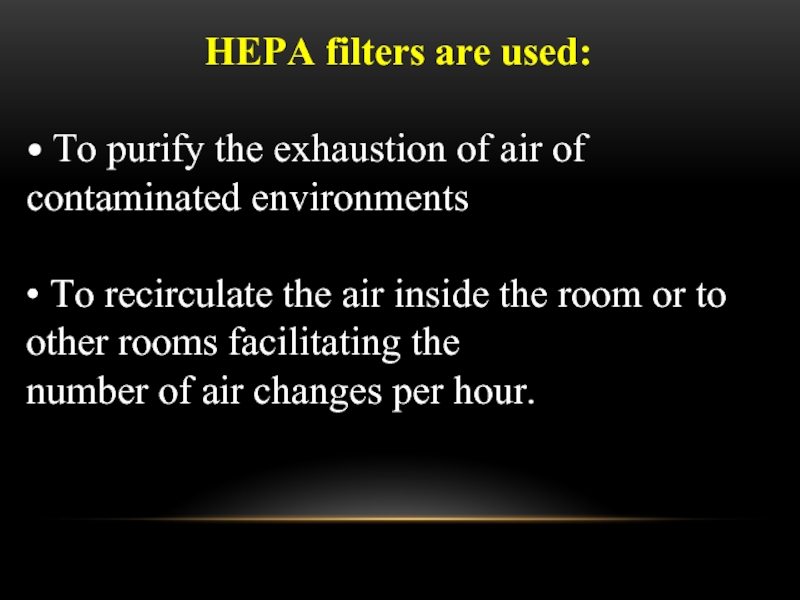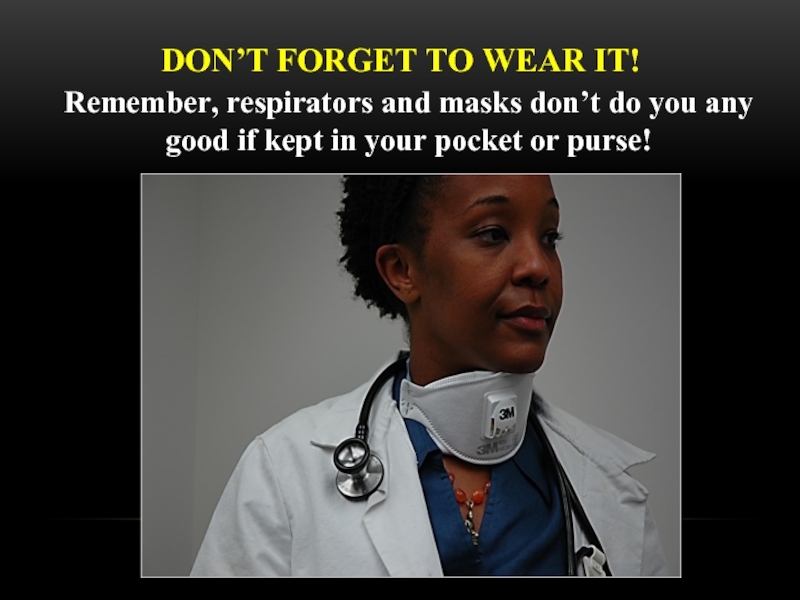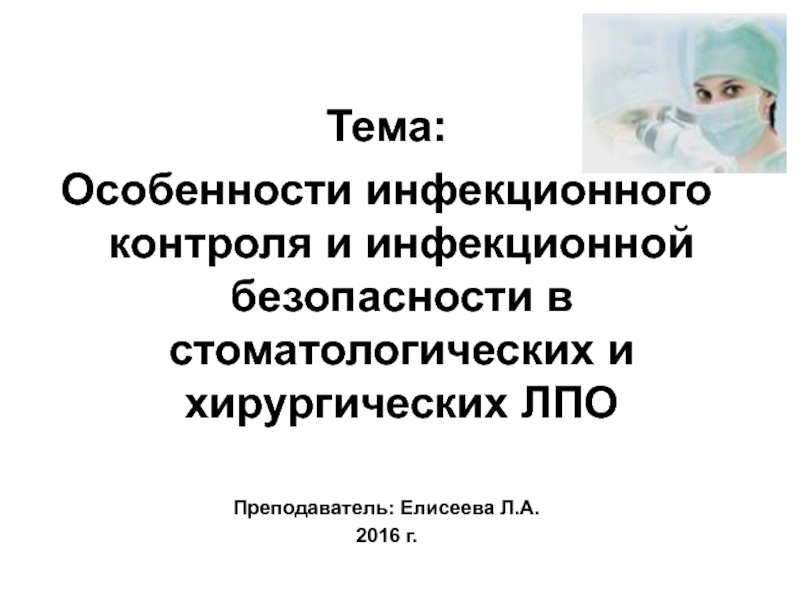- Главная
- Разное
- Дизайн
- Бизнес и предпринимательство
- Аналитика
- Образование
- Развлечения
- Красота и здоровье
- Финансы
- Государство
- Путешествия
- Спорт
- Недвижимость
- Армия
- Графика
- Культурология
- Еда и кулинария
- Лингвистика
- Английский язык
- Астрономия
- Алгебра
- Биология
- География
- Детские презентации
- Информатика
- История
- Литература
- Маркетинг
- Математика
- Медицина
- Менеджмент
- Музыка
- МХК
- Немецкий язык
- ОБЖ
- Обществознание
- Окружающий мир
- Педагогика
- Русский язык
- Технология
- Физика
- Философия
- Химия
- Шаблоны, картинки для презентаций
- Экология
- Экономика
- Юриспруденция
Prophylaxis of tuberculosis. (Lecture 4) презентация
Содержание
- 1. Prophylaxis of tuberculosis. (Lecture 4)
- 2. Prophylaxis of tuberculosis: Social,
- 3. Social prophylaxis Principles of prophylactic orientation,
- 4. A social prophylaxis is directed on:
- 5. BCG VACCINE attenuated (virulence-reduced) live bovine tuberculosis
- 6. Because the living bacilli evolve to make
- 7. Microscopic image of the Calmette-Guérin bacillus, Ziehl–Neelsen stain, magnification:1,000
- 8. The bacille Calmette-Guérin (BCG) vaccine has existed
- 9. The biological interaction between MTB and the
- 10. RECOMBINANT BCG VACCINE
- 11. is used for active specific prophylaxis of
- 12. BCG-M vaccine is manufactured in
- 13. BCG-STRAINS There have been many (WHO estimated
- 14. when the vaccine had been administered in
- 15. VACCINATION PROCEDURE BCG is given as a
- 16. THE RULES OF TRANSFUSION
- 17. IN 4-6 WEEKS pustule
- 18. IN 6-8 WEEKS crust
- 19. IN 2-4 MONTHS cicatrix
- 20. BCG IN ADOLESCENTS AND ADULTS There is
- 21. BCG IN HIV-INFECTED NEWBORNS In children who
- 22. COMPLICATIONS (BCG-RELATED DISEASES) CLASSIFICATION (WHO, 1984)
- 23. The term "BCG lymphadenitis" is usually coined
- 24. There are two forms of BCG
- 25. Overlying skin changes is universal, with erythema,
- 26. BCG LYMPHADENITIS Three treatment options have been
- 27. developing 3-4 weeks after vaccination COMPLICATION: ULCER
- 28. COMPLICATION: CHELOID CICATRIX
- 29. Osteitis after BCG vaccination is a rare
- 30. Clinical manifestations usually occur 18 months
- 31. GENERALIZED BCG-INFECTION Generalized infection due to BCG
- 32. LATENT TB INFECTION Latent tuberculosis infection (LTBI)
- 33. PREVENTIVE CHEMOTHERAPY Guidelines on the management of
- 34. PREVENTIVE CHEMOTHERAPY Systematic testing and treatment of
- 35. PREVENTIVE CHEMOTHERAPY Systematic testing and treatment of
- 36. PREVENTIVE CHEMOTHERAPY Systematic testing for LTBI is
- 37. PREVENTIVE CHEMOTHERAPY Individuals should be asked about
- 38. PREVENTIVE CHEMOTHERAPY Either TST or IGRA can
- 39. FOR RESOURCE-LIMITED COUNTRIES AND OTHER MIDDLE-INCOME COUNTRIES
- 40. PREVENTIVE CHEMOTHERAPY Treatment options recommended for LTBI
- 41. MDR-TB CASES Strict clinical observation and close
- 42. RISK OF DRUG RESISTANCE FOLLOWING LTBI TREATMENT
- 43. INFECTION CONTROL OF TUBERCULOSIS
- 44. EMPHASISE THAT TRANSMISSION IS NOT ONE-WAY AND
- 45. HIERARCHY OF INFECTION PREVENTION & CONTROL
- 46. ADMINISTRATIVE CONTROLS Develop and implement written policies
- 47. ENVIRONMENTAL CONTROLS: VENTILATION AND AIR FLOW
- 48. EVIDENCE FROM PERU Open windows and doors
- 49. ESTIMATED RISK OF AIRBORNE TB INFECTION
- 50. Direction of Natural Ventilation and Correct Working
- 51. Direction of Natural Ventilation and Correct Working Locations
- 52. Direction of Natural Ventilation and Correct Working Locations
- 53. Direction of Natural Ventilation and Correct Working
- 55. ENVIRONMENTAL CONTROLS Ultraviolet Light
- 56. PERSONAL RESPIRATORY PROTECTION Respirators: Can protect HCWs
- 57. N95 RESPIRATOR DOS AND DON’TS
- 58. Be sure your respirator is properly fitted!
- 59. Note poor fit at the bridge
- 60. High efficiency particulate air (HEPA) filters
- 61. The use of HEPA filters and/or UV
- 62. HEPA filters are used: • To
- 63. DON’T FORGET TO WEAR IT! Remember,
- 64. THANK YOU FOR YOUR ATTENTION!
Слайд 1PROPHYLAXIS OF TUBERCULOSIS
ZAPORIZHZHIA STATE MEDICAL UNIVERSITY
DEPARTMENT OF PHTHISIOLOGY AND PULMONOLOGY
R.N. YASINSKYI
(PhD,
Слайд 2Prophylaxis of tuberculosis:
Social,
Infectious control,
Sanitary,
BCG vaccination,
Preventive Chemotherapy
Слайд 3Social prophylaxis
Principles of prophylactic orientation, state character, toll-free medi-care are fixed
It is carried out due to the measures of socio-economic character of state scale.
Слайд 4A social prophylaxis is directed on:
making healthy of environment;
it is
it is strengthening of health of population;
it is an improvement of feed and vitally domestic terms;
it is development of physical education and sport;
are measures on a fight against alcoholism, drug addiction, smoking, other harmful habits.
Слайд 5BCG VACCINE
attenuated (virulence-reduced) live bovine tuberculosis bacillus, Mycobacterium bovis, that has
Bacillus Calmette–Guérin (historically Vaccin Bilié de Calmette et Guérin commonly referred to as Bacille de Calmette et Guérin or BCG) is a vaccine against tuberculosis that is prepared from a strain of the
Слайд 6Because the living bacilli evolve to make the best use of
The BCG vaccine can be anywhere from 0 to 80% effective in preventing tuberculosis for a duration of 15 years.
Слайд 8The bacille Calmette-Guérin (BCG) vaccine has existed for 80 years and
Слайд 9The biological interaction between MTB and the human host is complex
Слайд 11is used for active specific prophylaxis of tuberculosis – dry for
These are live mycobacteria of vaccine strain, lyophilicly dried in 1,5 % solution of sodium glutaminate. It looks like a white dried mass.
It is manufactured in ampullas of 1 mg of vaccine, which contains 20 doses, each of 0,05 mg of the preparation. BCG vaccine is used intracutaneously in a dose of 0,05 mg in the volume of 0,1 ml.
The primary vaccination is done to healthy, delivered at the right time newly borns on the 3-5th day of their life.
Tuberculosis vaccine (BCG)
Слайд 12BCG-M vaccine
is manufactured in a half dose (0,5 mg
is meant for vaccinating prematurely newly borns and children who were not immunised at birth in connection with contraindications, as well as for vaccination and revaccination of children, who live in the territories (areas) contaminated with radionuclides (III-IV zone).
Слайд 13BCG-STRAINS
There have been many (WHO estimated 40 or more in 1999)
Слайд 14when the vaccine had been administered in infancy, as is recommended
Слайд 15VACCINATION PROCEDURE
BCG is given as a single intradermal injection at the
Слайд 16THE RULES OF TRANSFUSION
The dry vaccine
The vaccine is used during 2-3 hours, the remnant is destroyed by boiling.
0,2 ml of the dissolved vaccine is taken into 1-gram syringe after mixing, the air and part of the preparation up to 0,1 ml mark is evacuated through the needle.
The vaccine is injected strictly intracutaneously on the limit between the upper and the middle third part of the shoulder, having previously rubbed the skin with 70° spirit.
At the proper technique a whitish papule of 5-6 mm in diameter is formed, which resolves in 15-20 minutes.
Слайд 20BCG IN ADOLESCENTS AND ADULTS
There is no evidence that revaccination with
However, given the serious consequences of developing multidrug-resistant disease and the low reactogenicity of the vaccine, BCG vaccination may be considered for all HIV-negative, unvaccinated, tuberculin-negative persons who are in an unavoidable close exposure to multidrug-resistant tuberculosis (MTB) (e.g. health care workers in facilities still lacking of proper TB infection control measures in place).
Слайд 21BCG IN HIV-INFECTED NEWBORNS
In children who are known to be HIV-infected,
In infants whose HIV status is unknown and who are born to HIV-positive mothers and who lack symptoms suggestive of HIV, BCG vaccine should be given after considering local factors. Such factors are likely to be important determinants of the risk-benefit balance of such an approach and include: coverage and success of the prevention of mother to child transmission of HIV programme; possibility of deferring BCG vaccination in HIV-exposed infants until HIV infection status has been established; availability of early diagnosis of HIV infection in infants; and, provision of early ART to HIV-positive infants.
Слайд 22COMPLICATIONS (BCG-RELATED DISEASES) CLASSIFICATION (WHO, 1984)
Local (the most frequent) –
Disseminated BCG-infection (osteitis, lupus).
Generalized BCG-infection with lethal outcomes.
Post-BCG syndrome (cheloid cicatrix, nodular erythema, allergic rash).
Слайд 23The term "BCG lymphadenitis" is usually coined when ipsi-lateral axillary, supraclavicular
BCG LYMPHADENITIS
Слайд 24
There are two forms of BCG lymphadenitis.
The nonsuppurative form (simple form)
The suppurative form is marked by the progressive enlargement of regional lymph nodes leading to a collection of suppurative material, with recognisable fluctuation in the swelling.
BCG LYMPHADENITIS
Слайд 25Overlying skin changes is universal, with erythema, edema, increased pigmentation and
Wound healing inevitably takes several months, which is unpleasant to both patients and their care providers. Frequent and meticulous wound dressing is required, and secondary bacterial infection, unsightly scarring or keloid formation are not uncommon sequelae.
BCG LYMPHADENITIS
Слайд 26BCG LYMPHADENITIS
Three treatment options have been described for BCG lymphadenitis.
Antibiotic Therapy
Several
It should also be noted that BCG is generally not susceptible to pyrazinamide, a first-line agent for treating TB. Antibiotic therapy is, however, often indicated for treatment of suppurative lymphadenitis proven to be caused by superinfection with pyogenic bacteria such as Staphylococcus aureus or Streptococcus pyogenes, as definitive therapy or an adjunct to surgical intervention.
Needle Aspiration
For suppurative BCG lymphadenitis, given time there is almost universal development of spontaneous perforation and sinus formation if left untreated. Recent studies have shown that needle aspiration can help to prevent this complication and shorten the duration of healing, apart from offering valuable diagnostic information.
Surgical Excision
Surgical excision is a definitive way to remove the affected lymph node(s) and promote early cure and better wound recovery.
Слайд 29Osteitis after BCG vaccination is a rare condition, with an incidence
Bone involvement occurs due to lymphohematogenous dissemination, and the lesion site is not necessarily associated with the injection site. The sites most often affected are the tibia, femur, vertebrae, sternum and ribs.
DISSEMINATED BCG-INFECTION
Слайд 30 Clinical manifestations usually occur 18 months after vaccination, this interval
The initial symptoms are sensitivity, pain and limited movement of the affected region. When present, fever is low and does not affect the general status of the individual.
On X-rays, lytic lesions with a sclerotic halo can be seen, as can periosteal reaction and periarticular osteoporosis.
Histopathological studies show granulomatous inflammation with epithelioid cells, with or without caseous necrosis. Acid-fast bacilli are detected in approximately half of all cases, and most present strongly positive PPD reactions.
It recommends treatment with isoniazid and rifampin for 12 months.
In most cases, long-term antituberculosis therapy and surgical drainage are necessary for remission. Fortunately, the prognosis is good, with a low frequency of complications. Therefore, the use of BCG vaccine should be maintained in countries with a high incidence of TB.
DISSEMINATED BCG-INFECTION
Слайд 31GENERALIZED BCG-INFECTION
Generalized infection due to BCG vaccination has also been reported,
According to Mande, 1980, the first case was reported in 1953, 30 years after BCG had first been applied to man. Between 1954 and 1980, 34 cases were published in the global literature, and the Lotte et al. study estimates the incidence as 2.19 per one million vaccine recipients. Nevertheless, three recent Canadian cases were reported in 1998. Severe and generalized BCG infection that may occur in immunocompromised individuals should be treated with anti-tuberculous drugs including isoniazid and rifampicin (Romanus et al., 1993).
Слайд 32LATENT TB INFECTION
Latent tuberculosis infection (LTBI) is defined as a state
One third of the world’s population is estimated to be infected with M. tuberculosis. The vast majority of infected persons have no signs or symptoms of TB disease and are not infectious, but they are at risk for developing active TB disease and becoming infectious. The lifetime risk of reactivation TB for a person with documented LTBI is estimated to be 5–10 %, with the majority developing TB disease within the first five years after initial infection.
However, the risk of developing TB disease following infection depends on several factors, the most important one being the immunological status of the host.
Слайд 33PREVENTIVE CHEMOTHERAPY
Guidelines on the management of latent tuberculosis infection were developed
The guidelines are also intended to provide the basis and rationale for the development of national guidelines. The guidelines are primarily targeted at high-income or upper middle-income countries with an estimated TB incidence rate of less than 100 per 100 000 population.
Resource-limited and other middle-income countries that do not belong to the above category should implement the existing WHO guidelines on people living with HIV and child contacts below 5 years of age.
Слайд 34PREVENTIVE CHEMOTHERAPY
Systematic testing and treatment of LTBI should be performed in
(Strong recommendation, low to very low quality of evidence)
Слайд 35PREVENTIVE CHEMOTHERAPY
Systematic testing and treatment of LTBI should be considered for
(Conditional recommendation, low to very low quality of evidence)
Слайд 36PREVENTIVE CHEMOTHERAPY
Systematic testing for LTBI is not recommended in people with
(Conditional recommendation, very low quality of evidence)
Слайд 37PREVENTIVE CHEMOTHERAPY
Individuals should be asked about symptoms of TB before being
(Strong recommendation, low quality of evidence)
Слайд 38PREVENTIVE CHEMOTHERAPY
Either TST or IGRA can be used to test for
(Strong recommendation, low quality of evidence).
IGRA should not replace TST in low-income and other middle-income countries.
(Strong recommendation, very low quality of evidence)
Слайд 39FOR RESOURCE-LIMITED COUNTRIES AND OTHER MIDDLE-INCOME COUNTRIES THAT DO NOT BELONG
People living with HIV and children below 5 years of age who are household or close contacts of people with TB and who, after an appropriate clinical evaluation, are found not to have active TB but have LTBI should be treated.
(Strong recommendation, high quality of evidence)
Слайд 40PREVENTIVE CHEMOTHERAPY
Treatment options recommended for LTBI include:
6-month isoniazid, or
9-month
or 3-month regimen of weekly rifapentine plus isoniazid,
or 3–4 months isoniazid plus rifampicin, or 3–4 months rifampicin alone.
(Strong recommendation, moderate to high quality of evidence).
Слайд 41MDR-TB CASES
Strict clinical observation and close monitoring for the development of
Clinicians can consider individually tailored treatment regimens based on the drug susceptibility profile of the index case, particularly for child contacts below 5 years of age, when benefits can outweigh harms with reasonable confidence.
Слайд 42RISK OF DRUG RESISTANCE FOLLOWING LTBI TREATMENT
A systematic review was conducted
Isoniazid for 6- to 12-month duration: Thirteen studies comparing 6- to 12-month isoniazid preventive therapy versus no treatment or placebo were included in the systematic review (seven involving HIV uninfected populations); no difference in the risk of resistance among incident TB cases was found (risk ratio = 1.45 (95% CI: 0.85–2.47)). There was little evidence of heterogeneity (p=0.923) and the risk ratio for HIV-uninfected and HIV-infected populations was comparable. The quality of the evidence was moderate.
Isoniazid for 36 months in HIV-infected individuals:Three studies comparing 36- and 6-month isoniazid were reviewed but only one study provided resistance rates, and no significant Difference in drug resistance was found (risk ratio = 5.96 (95% CI: 0.24–146) (24). The two other studies reported that the observed proportion of resistant cases were similar to the expected rate in the background population, but did not provide a direct comparison of resistance rates between those receiving 36 months compared to those receiving 6 months treatment (25,26). Therefore, it was concluded that there is no evidence to indicate whether or not continuous use of isoniazid increases the risk of isoniazid resistance.
Слайд 44EMPHASISE THAT TRANSMISSION IS NOT ONE-WAY AND DOES NOT DISCRIMINATE! PATIENTS CAN
Patient to:
Worker
Visitor
Patient
Worker to:
Worker
Visitor
Patient
Visitor to:
Worker
Visitor
Patient
Слайд 45HIERARCHY OF
INFECTION PREVENTION & CONTROL
Administrative controls
Reduce risk of exposure, infection
Environmental (engineering) controls
Reduce concentration of infectious bacilli in air in areas where air contamination is likely
Personal respiratory protection
Protect personnel who must work in environments with contaminated air
Слайд 46ADMINISTRATIVE CONTROLS
Develop and implement written policies and protocols to ensure:
Rapid identification
Isolation of patients with PTB
Rapid diagnostic evaluation
Rapid initiation treatment
Educate, train, and counsel HCWs about TB
To the extent possible, avoid mixing TB patients and HIV patients in the hospital or clinic setting
Слайд 47ENVIRONMENTAL CONTROLS:
VENTILATION AND AIR FLOW
Ventilation is the movement of air
Should
Types
Natural
Local
General
Simple measures can be effective
Слайд 48EVIDENCE FROM PERU
Open windows and doors produced 6x greater air exchanges
Natural ventilation in “old-style” hospitals and clinics resulted in much better ventilation and much lower calculated TB risk, despite similar patient crowding
More likely to have larger, higher ceilings; larger windows; windows on opposite walls allowing through-flow of air
Слайд 49ESTIMATED RISK OF
AIRBORNE TB INFECTION
Naturally ventilated, windows closed - 97%
Mechanically
Naturally ventilation, windows and doors fully open:
Modern (1970-1990) - 33%
Old-fashioned (pre-1950) - 11%
Слайд 50Direction of Natural Ventilation and Correct Working Locations
When increasing ventilation
Слайд 53Direction of Natural Ventilation and Correct Working Locations
Remember, the patient is
Слайд 55ENVIRONMENTAL CONTROLS
Ultraviolet Light
HEPA (high efficiency particulate air) filters
Both indirect ultraviolet irradiation
Слайд 56PERSONAL RESPIRATORY PROTECTION
Respirators:
Can protect HCWs
Should be encouraged in high-risk settings
May be
Face/surgical masks:
Act as a barrier to prevent infectious patients from expelling droplets
Do not protect against inhalation of microscopic TB particles
Слайд 59
Note poor fit at the bridge of nose
Note poor fit at
Respirator should cover chin and create a seal
Слайд 60High efficiency particulate air (HEPA) filters
HEPA filters or absolute filters
Слайд 61The use of HEPA filters and/or UV light is strongly recommended
bronchoscopy,
induced sputum,
pentamidine nebulization,
necropsy,
isolation.
The combination of an adequate number of air changes with negative pressure and a HEPA filter or UV light minimizes the risk of transmission in the environment in which the TB patient is assisted and in the area where the air is exhausted. The germicidal efficiency of the UV light is limited to its area of direct incidence and decreases with time
Слайд 62HEPA filters are used:
• To purify the exhaustion of air of
• To recirculate the air inside the room or to other rooms facilitating the
number of air changes per hour.
